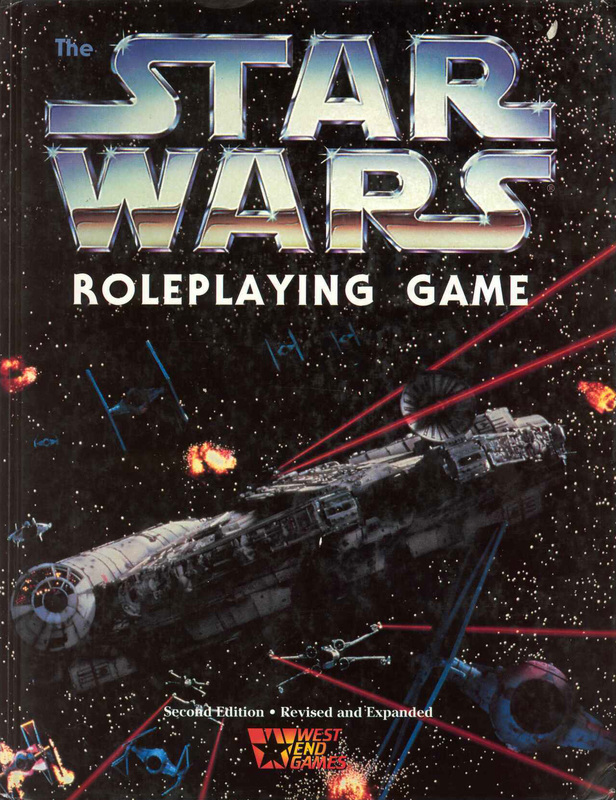 So what's the Prime Directive when you sit down to roll up a character for an RPG? Do you enjoy making up characters totally unlike your 'real' self and playing them to the hilt? Do you just make whatever the party needs, placing more value on moving the story forward than on playing a specific role? Or are you one of the rare few who truly like the complexity of a rules set, lawyering every last +2 bonus you can get and figuring out probability and power curves for every min-maxed build? Me, I'm a fan-boy. When I roll a fantasy rogue, I'm seeing Fritz Leiber's Grey Mouser. When I make a Traveler character (that actually survives character creation), I'm thinking Ellen Ripley or Honor Harrington. Cyberpunk? Yeah, maybe I've copied Case from William Gibson's Neuromancer once. Or twice. Or every damned time. It's a natural urge to put yourself in your hero's shoes. You read the books, you watch the movies, you maybe write the fan-fiction (The serious kind, or maybe even the slash kind, whatever soaps your rope). It's comfortable and it's natural, but it's also limiting. The point of an RPG is to cut loose with the imagination. Nobody wants to hear how well you can shoehorn Sindarin Elvish into a straight-up, kick-in-the-door dungeon crawl. When your character never goes beyond the inspiration material, the game becomes a fan-fic centered around you, and that's not fun for anybody. It's hard enough to leash your inner fan-boy/girl in a normal RPG, but what about when an entire game system is specifically based on an existing Intellectual Property, a big-name world that gets its own exhibit hall at ComiCon? How do you play that kind of system without falling mechanically into the existing plot? Can it be more than group fan-fiction? Well, I've been to the mountain top, and the answer is yes: you can make a popular fictional world into more than a long string of script-quoting and inside jokes, but it ain't easy. It takes conscious effort and mutual support from the whole table. Fun Facts: 1. You WILL play Han Solo... Or Malcolm Reynolds. Or Angel. Or Jaime Lannister. No matter how hard you try, you will end up with a character carbon-copied from the Hallowed Source Material. Look, it's not really your fault. Look at the Serenity/Firefly RPG: I really like it. The Cortex system is close enough to Savage Worlds to be comfortable, and the books themselves are gorgeous: full color art, stills from the show, quotes from the original script liberally scattered throughout. The book really evokes the spirit of the show, and that's the whole point. But it also makes it damned near impossible to roll up a ship that's much different from Serenity or a crew that doesn't have a plucky mechanic, a smart-ass pilot and a dogged, heroic Captain with a moral code. We love the world, and want to play in it; but, even more, we love the gorram characters, right? And when the rules plaster those characters on every page, it's hard to avoid the influence. 2. ...and That's Perfectly Okay Of course you're going to play an iconic character, thinly re-skinned (What? My smuggler is named Wan Single, and his copilot is a Bothan, not a Wookie, so it's totes original). And, when you're first starting out, that's entirely cool. What better way to get a feel for playing in the Star Wars universe than playing a version of a known character? You already know what Han would do in a given situation (shoot first, duh) and that serves as a great set of training wheels for getting into the swing of things. So go ahead and roll up a Jaime Lannister. Have him “pay his debts”. Spend a few dice throws being a cocky ass and making out with your sister (maybe). Use the familiarity of the character to really get into the world. 3. Then Let It Go. Annoying biographical example: I recently got into a Star Wars: Edge of the Empire campaign. We were all starting fresh, so we used the pre-gen characters in the starting set. My pre-gen boy Pash? Well, let's just say the folks at Fantasy Flight Games wanted the Han Solo fans to be represented. We played the introductory adventure, and I played Pash pretty much like Han: smart mouth, fast blaster, shoot first. But, towards the end of the session, I'll be damned if the guy didn't start to develop a personality of his own. He started to veer into Lando territory, a bullshit artist with a true criminal streak, the kind of guy who will fight the Empire, but only if Leia wears the bikini. He was kind of a dick, and he was fun to play, and he wasn't Han Solo. By the third night we played, I had him a whole back-story, and the only way he resembled Han Solo was that he was flying a Corellian YT-1300 freighter. Because… When you dig right down into it, no RPG character survives the first session. Whatever idea you had, rolling all those d6's and dog-earing pages in your player's guide, it morphs the minute you bring other players into the situation. With a decent GM behind the screen, you'll soon find your cardboard-cutout character becoming a stand-alone person: sure the basic inspiration is always there, but your own personality and the influence of the other players will make your character one that can stand alone, even in a world-famous setting. And when that happens, you'll find your inner fan-person skweeee-ing like crazy, because, in an obscure way, you've truly put yourself into that world. It's no longer just George Lucas, or Joss Whedon, or GRRM's world; now you've written your own little piece of it. Jack Benner is a back-sliding follower of St. Cuthbert. He writes about all kinds of things for Stick in the Mud Press (stickinthemudgames.blogspot.com) 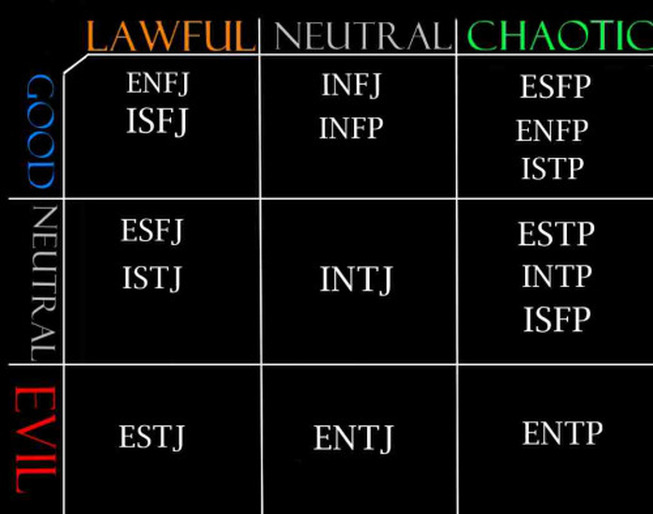 The MBTI (Myers-Briggs Type Indicator) is, for all you non-psychology nerds, a personality inventory and test to make C.G. Jung’s theory of psychological types understandable and relatable to the average person. Essentially, Jung tried to tell us that our behaviour has order and is consistent based on how we use our perception and judgement. There are 16 distinct personality types derived from 4 preferences, according to the Meyers Briggs website:
What does this have to do with role-playing, you ask? Well, the answer is simple. Role-playing is a social game, thriving on communication. It is important to get to know the people behind the characters, as well as what they will bring to the table. We’ve included some descriptions of each personality type, as well as what they can bring to your role-playing group below. See if you can guess which personality fits with the players at your table. 1. ISTJ – The Logistician “Logisticians” are one of the most common personality types, and are defined by their integrity, reliability, and practical logic. They are also highly dedicated, whether that is to the military, law, or any personal role. They take pride in their work and hold strong to tradition and family values. In game, don’t expect this player to be carefree and easygoing; they’re far too logical for such nonsense. They will always work to understand their characters’ situations and respond accordingly with the best plan available to them. 2. ISFJ – The Defender “Defenders” are kind to a fault. They are engaging, exceed expectations, and are often meticulous in anything to which they set their minds. They are very humble, dedicated, and often don’t know when to say “no”. In game, their strong drives to assist their fellow players will often lead them to find gratification in playing a support role. Often shy, they may not handle in-game confrontations well, as it will often be taken personally. And that means no healing for you. 3. ISTP – The Virtuoso “Virtuosos” are very in tune with their senses, tending to examine the world around them. They are very curious, creative, project-driven people, finding no greater joy than getting their hands dirty and taking things apart to see how they work. In game, you won’t find a more practical player. This can be good, such as when planning for an adventure or finding solutions to problems, or it can be bad, especially given the inherent impracticality of many of the role-playing scenarios with which they must deal. Insensitivity to others’ emotions and a penchant for boredom if something is taking too long might lead this player to act rashly or escalate conflicts just to keep things interesting. 4. ISFP – The Adventurer “Adventurers” are true artists that desire to push the limits of social convention. They are quiet, experimental people that need to have space to be creative, imaginative, and let their passions and worldly curiosities show. In game, this is a player who will be quite popular. Naturally artistic, their active imaginations will bring the game to life for themselves when a player or for others when a GM. Their unpredictability and irrationality may irritate the more straightforward thinkers in the group, but when you’re this likeable, such things matter little. 5. ESFJ – The Consul “Consuls” are the popular ones, probably taking the spotlight and leading their teams to victory. They are very social, making sure they have the inside scoop on what their friends are up to. They are very focused on external matters, such as their appearance or fashion, rather than intellectual matters. In game, this player will be the one everybody likes, so much that they might get preferential treatment from the GM. However, their characters may mirror their need to be universally liked, which is especially unfortunate if playing an uncharismatic sort (or a smelly ogre). 6. ESFP – The Entertainer “Entertainers” love to put on a show for anyone who will show them attention. They have an eye for fashion and style, and will focus most of their time on immediate pleasures rather than the responsibilities that make those luxuries possible. In game, expect this player to go all out when playing their character. They will inject their own brand of creativity and imagination into every character they make. As such, they will thrive in a more story-focused group. This player will also likely become quickly bored if someone else attempts to ‘plan’ or ‘strategize,’ as such things aren’t what makes role-playing so much fun. 7. ESTJ – The Executive “Executives” are your classic model citizen. They will lend a helping hand, make sure rules are followed, and have a strong focus on making our communities and neighbourhoods fit for everyone. They make great leaders as they enjoy creating order, are very straightforward, and never give up on their beliefs. In game, this player will gravitate towards the more ‘lawful’ alignments for their characters. They might struggle when faced with some of the more unconventional situations encountered when role-playing, but they will excel at organizing the group’s play sessions and will always show up on time. 8. ESTP – The Entrepreneur “Entrepreneurs” love to be the center of attention, cracking jokes and entertaining everyone, ignoring all those that want to be serious and discuss world news. They thrive on drama and fast paced, “on the edge” living. In game, this player is the very antithesis of cautious thinking and prior planning. As such, they will be incredibly fun to play with and the stories which come out of their games will likely be epic (and feature them strongly). Just don’t expect all these stories to end in success. 9. INTJ – The Architect “Architects” are strategic, quick thinkers with a high self-confidence and are very determined when they put their mind to a task. They are jacks-of-all-trades and excel at analyzing anything life throws their way. In game, this will be the player who always has a plan for every situation. While their plans will often work, they may become sulky if someone else’s plan is chosen (regardless of whether or not the plan actually works…) 10. INTP – The Logician “Logicians” are novel theorists and have an unrelenting logic. They will frequently use you as a sounding board for their ideas, despite their ideas being quite undeveloped. They are private, withdrawn, and can be absent-minded since they are always in their own head, formulating their incomplete thoughts. In game, this person will think they have a deep understanding of how the game should be played (i.e. the rules) and won’t be afraid to let their fellow players know it. This is the personality type most prone to rules lawyering, which is unfortunate because when it comes to the rules, they will be right. 11. INFP – The Mediator “Mediators” are idealistic people look for the good in anyone and anything, as well as for a way to make life better. They are often reserved and guided by their principles, looking to honour, beauty, morality, and virtue. In game, they will be the first in line to help solve the group’s pressing problems, most likely diffusing any tension with a sonnet or a witty limerick. This person will often act as the group’s moral conscience and tend toward an act of heroics to save the day. 12. INFJ – The Advocate “Advocates” are creative, insightful, and always need to have a cause. Helping others is their purpose in life, and they desperate to get to the heart of issues and will often sacrifice what they need to help the common good. In game, this player will likely speak less than any other; however, their engagement in the story and care for their fellow players (both in and out of game) makes them a worthy asset to any game group. 13. ENTP – The Debater “Debaters” play devil’s advocate, picking apart arguments until there are only little pieces in a pile on the floor. They have an effortlessly quick wit and are stellar at connecting all the dots to prove a point. In game, the phrase ‘problem focused’ will be applied to this player more than ‘solution focused,’ as they will tend to find any potential flaws in the groups’ plans. Take their advice with a grain of salt, however, as listening too closely to them will leave the group discussing how to simply enter a guarded room or cross a trapped bridge for hours on end. 14. ENTJ – The Commander “Commanders” are natural-born leaders, with all the charisma, confidence, and determination it takes to achieve any of their goals. However, they can often be impatient, intolerant, or even stubborn, always wanting the upper hand. In game, this person will attempt to take charge of the group, as they have the plan and logical mind needed to lead. They can unintentionally bully the timid or less vocal to following their lead and heaven help a group with more than one of these rare beasties, as internal power struggles will arise. 15. ENFP – The Campaigner “Campaigners” are free-spirits that are the life of the party. They look for the deeper meaning and have an energy that makes them a leader, which is often times undesired by the “campaigners” as they want an independent environment. In game, this person is often the life of the party, creating and acting out vibrant personalities for their characters. They excel at relating to other people (both PCs and NPCs) but can become bored if the routine administrative tasks associated with gaming (i.e. inventory management, tactics and planning, etc.) interfere too much with their role-playing. 16. ENFJ – The Protagonist “Protagonists” are natural-born leaders with passion and charisma, and they are often an inspiration to others. They are often our teachers, coaches, and world leaders, and will cast aside anyone that stands in the way of a brighter future. In game, this player will also be vying for the group leader but they will approach it from a more human perspective. Good at working for and with their fellow players, they will do well to heed the advice of the planners in the group. Too much stubbornness could cause problems. #MakeAmericaGreatAgain I hope this inspires you to take the test or to share this with others on your game night to learn more about your preferences as individuals and as role-players. The ramblings on the different personality types included herein are just our opinions on the matter and don’t constitute any actual scientific findings. Regardless, thank you for reading our baseless drivel anyways. This article was co-written by Jake, the husband of Sam and an INTP, and Sam, the wife of Jake and an INFJ. He understands that he knows the rules better than most of the people but tries to keep it to himself. She realizes her tendency to be the quiet one and hopefully makes up for it with delightful writing and whatever, I don’t know. 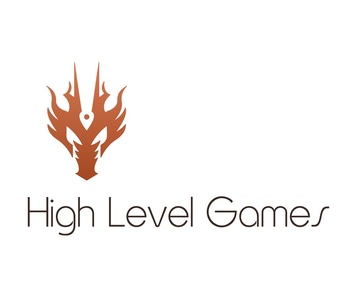 I thought I would write up some thoughts about what we are looking for in regards to being a part of our creative community. Things to know in no particular order: 1. I personally do all of the editing work. This is a volunteer effort and a passion project. What that means is that I have an uneven amount of time to focus on your work and prep, edit, set it for the site, find artwork, publish it, and then try and get it out to as many people as I can. Some weeks I am very busy at my real job, and things slip past me, and other times less so. Basically you can do yourself and me a tonne of favours by simply handing in an article that is as finished and polished as is possible. That way, there are fewer things for me to catch, so if I don’t, it isn’t as bad. 2. Send it in as a Word doc. Further, try not to overly format it. What I mean is that a lot of it I have to trip out and redo as I post it on the site anyways, so I use it more as reference to what you are trying to express than a situation where it is copied exactly. Chief amongst these are automatic numbering, I always remove them. It’s not a deal breaker, but still. 3. Feel free to contact us here on the site, on Facebook, on Twitter, or whatever in order to let me know that you are interested in creating for us. We may or may not be interested. We want this to be a community of creative fans that can pool their stuff and get it out to other passionate fans, who can use this as an accessible single stop for information, tips, and inspiration for table-top RPGs and random other geek culture. Everything is volunteer by passionate fans for passionate fans. We just love our hobby and saw a niche we thought we could fill. 4. We do listicle, at least for now. It is easier on our authors it is a format that support being an easy read, and accessible to busy folks, and is nice in that it gives an easy to grasp format for authors. And frankly we have seen that in the right hands our authors can get surprising depth out of the format. Listen, I know there are amazing things that you want to give us in essay format, and soon we may be looking at hosting pieces of work like that as well. But if and when we do, at least at first, we will be looking to our columnists and guest bloggers who have a previous relationship with us when we do. I hope that doesn’t sound too harsh. This is all designed to grow the hobby and positively engage the community. And so any change or expansion we do must be well thought out and needs to be something that we have time to support and do well. 5. Speaking of format – Introduction of topic, numbered list, conclusion, bio. 6. Include a bio at the end of every submission. This should be relatively short, but can be pretty much anything you like, which could and should include anything you want to promote, from your social media accounts to any projects or products you want to get out there. 7. Help out by getting the word out. If you belong to a forum, a Facebook group, Twitter, or whatever share our stuff. Join our Facebook group, subscribe to the podcast on iTunes, post this wherever you can, re-tweet us on Twitter, whatever. It helps get your stuff out there and a rising tide and all that… 8. The word, for us, is spelled “role-play.” And “table-top.” And titles should be done with every word capitalized. This is more for consistency than anything else. 9. We could use help with editing and scheduling on the blog section. If you are desirous of being an Editor, know that I have committed mistakes in grammar, punctuation, and morphology on this post. Find them. -VP Quinn 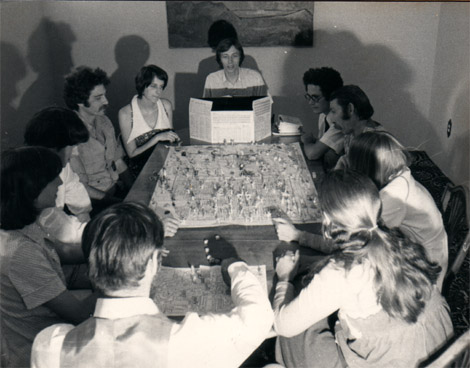 Long, long ago, in what I like to call ‘the before time’ (late 80s, early 90s), I read a piece of advice that would stay with me to this day. In a random comic book (X-Men, I vaguely remember), they had a couple of pages with some advice for potential artists/writers that wanted to come into the comic book world. Now me not being able to draw to save my life, I focused on the bit dedicated to writers. And it said something like this: Start small. Most comics and/or stories we get from would-be artists somehow have the X-Men, Galactus, The Fantastic 4 and Doctor Strange, all interacting and fighting in the first few pages. No one will believe or care for that. Start small, tell us what’s happening with the little guy. So that got me thinking, what is the best way to actually get a story out there? Not only published, I mean, how do you get a story/setting/RPG environment that the players engage with? 1. The little guy. Possibly the most important entity in RPG’s. Is it a coincidence that so many D&D games, throughout the generations, have started in taverns? That great melting pot of races and people? I think not. The characters, as extraordinary as they might be, have to be recognizable as ordinary, if only for a little while. (Perpendicularly, I feel this is the issue with Superman in movies, he’s too…. Super!) At the end of the day, if you don’t identify with the character you’re playing, you might as well be watching a movie. 2. NPCs have funny voices. Well, not necessarily funny voices, but they do need a hook. Maybe a scar, or a limp. Or yes, a funny voice. If you’re playing more than one adventure in that setting, do it. In two adventures time, when you bring the NPC round again, you’ll be rewarded with many a smile, and eye-rolling: ‘Not him again!’ NPC’s are your lifeblood. They are the way the GM interacts with the party, don’t underestimate them. 3. Invoke atmosphere, paint a picture. Don’t just say it’s a forest. How dark is it? Also, you’ve used only one sense so far. You have 4 more. What does it smell like? What can you hear? The wind? A stream? Fill in details, small ones, but if you use all the senses, it will be much more enveloping and engaging. 4. PROPS! For next to nothing, sites like Amazon and Etsy can provide you with countless small bits and bobs to help your adventures. I LOVE props. There’s the random map, of course. And then there’s the cheap plastic necklace, or the even cheaper bracelet that are now priceless magical items. I’ve used broken plastic jewels as gems and cheap plastic reproductions as the mystical Jade Dragon pendent (a necromantic stone). Make your players handle the prop. At that moment, it will become real to them. 5. ALL THE QUESTIONS! When I create a new game, in a new environment, (what I mean by world-building), I try and keep a couple of main sentences in my head. What is this Place about? Where is it? Why is it there? How is it there? Why should we care? These don’t need to be extensive answers, just enough to give you a working framework. 6. Dive down. Then, I aim to bring the focus down to street/path/trail level. Who are the people in it? Who would you cross paths with? What would the people look like? Would they identify with you, will they recognize you as a friend or as a foe? Are non-humans accepted or would they be discriminated against? It’s all well and good to play a Dragonborn, but not as fun if your presence will make every NPC want to kill your party. 7. Start at the bottom. How many times have you RPG'd a king? An emperor? The ruler of all you surveyed? Me? Zero. Oh don't get me wrong, I've interacted with princes, and dukes and kings. (Famously getting my character obscenely drunk after failing 4 Persuasion rolls in a row. And there was an insane duchess and an open bar. It's a long story.) But I've always played the little guy. Literature has been doing this for millennia. Lord of the Rings, Star Wars, you name it. Little guy? Overcoming insurmountable odds? There you go. These are the stories we care about. We need to identify with the characters, and feel we are in that environment. They can be mutated zombies wielding ray guns from dimension Z, but they need to be as flawed and as recognizable as ‘human’ in terms of fallibility as we are. You can play your RPG as a strategic game, with rulers and line of sight and distances. I have, and it is great fun. But for me, nothing beats a bunch of friends around a table, Role-playing. As the little guys. Rui is a scientist and teacher, but he's only been RPG'ing for a bit over a year. What he did with the rest of his life is not documented. When he has some free time, he can be found planning games as the GM, usually involving much paper, props, some maps and assorted core books. He likes pizza, the colour blue, cats and sci-fi. The reports that he wants to play a blue pizza-eating cat in a sci-fi RPG, are unsubstantiated. 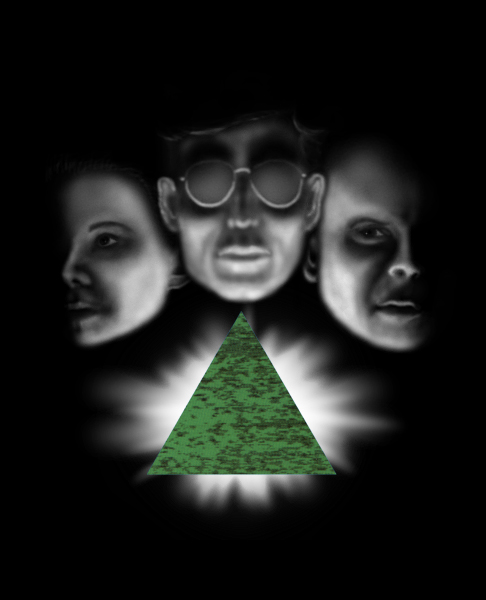 As the tabletop gaming hobby continues to age and mature, titles of all stripes are put on the shelves, many of which fall by the wayside. In a lot of cases, this is a good thing. Just because a core book is printed, doesn’t mean it’s worth your time. However, several of these obscure games are sparkling gems amidst the clutter of mundanity, and I’m going to tell you about the most intriguing four. 1. The World of Synnibarr, Second Edition Ever wondered what a combination of D&D, Cyberpunk, and a fever dream would look like? Look no further than Synnibarr, the brain vomit of one Raven c.s. McKracken (yes, the c.s. is lower case) and a few of his compatriots. The core book is all you’ll ever need, or want, in order to play the game, and contains every single ridiculous rule you can think of. These rules are cobbled together in the most convoluted way, with a ton of bits that an enterprising GM can simply strip from the game without issue. Once you get past what I view as the worst rule system ever created, however, you find yourself with the most hilarious and wondrous setting imaginable. The classes a player may choose from (so long as their character creation rolls are high enough) range from Ninja to Bio-Syntha Cyborg and everything in between. Each class has its own special abilities with no balance whatsoever governing them. One character may struggle to shoot a gun at point blank range, while your Cyborg buddy creates a sword out of pure energy and cuts him to pieces before you can blink. Damage in this game can go into the MILLIONS, and armor you wear does not reduce incoming damage via subtraction, like most systems. No, Synnibarr armor removes 0’s from your damage amount (transforming 10,000 damage into 10 damage, for instance). This particular system quirk led to my favorite moment, wherein the party was fighting a horde of nuclear bees (do not adjust your monitor, you read right), proceeding to knock them into the air so they explode harmlessly away from the group. Our Giant, whose armor and strength were leagues above anyone else’s, grabbed the last of volatile insects and spiked it on the ground in celebration. The whole party died, except for the Giant, who took about 5 damage while the rest took about 50,000. If you’re of age, I recommend alcohol be taken liberally with this particular pick for best results. Oh, and one last thing. Giant Flying Grizzly Bears, with Chi Eye Beams. And did I mention the world in which you play is hollowed-out-Mars-that-was-turned-into-a-spaceship-because-reasons? That is all. 2. Anima: Beyond Fantasy Originally Spanish made and produced, Anima made it to North America via the publishing power of Fantasy Flight Games. Even with this powerhouse of a partner backing the product, the game did not really gain traction in the main market. Luckily, it remained popular enough to warrant several expansion books, each of which add significantly to the setting of Anima and its systems. In stark contrast Synnibarr’s mess of rules that work against one another and barely interrelate, Anima’s various systems work together in perfect, fantastic harmony. The setting isn’t half bad either, and gives a new twist on the fantasy genre. Instead of half-orcs and elves, Anima gives us Nephilim, human offshoots born with the souls of ancient magical races. With Anima, you can truly build your perfect Anime-inspired or fantasy-born hero. Be it Jedi, Witcher, or Z-Fighter, no concept is off limits. The game allows three separate systems (Magic, Psychic, and Ki), that each feel completely distinct, to work together flawlessly. Build your own technique tree with Ki, mixing effects to achieve the perfect series of abilities that define your character. Your friends can choose a book of magic and hurl spells, while other party members can play brain-bending psychics and have limitless reserves of power, but at a higher cost. The combat system is variable and fluid, and relies as much on the speed of your character as it does their power. The game even allows GMs to create their own NPCs and enemies from scratch. To top it all off, everything I’ve mentioned is in the core book! Add in the extra books for more creatures, magic spells, and artifacts, and you have a robust game that makes combat feel exciting every time, and exploration incredibly rewarding. The only negative worth mentioning is the complexity of the game. I must warn that this is not a system for beginner GMs. Get a few games under your belt, then give this high-octane fantasy-fest a go. You won’t regret it. 3. Monsterhearts Need a break from the rules crunch? Think you can do a better job at crafting crazy teen drama than Twilight? Of course you can! Monsterhearts is a role-playing game that’s light on rules, yet heavy on the storytelling. What few rules exist (derived from the Apocalypse World engine) in the small core book help establish a framework within which players will build their monster. They establish connections and social standing, and pick their flavor of creature. During the course of the game, players and the MC (the game’s name for the GM) work against one another and use their special powers to gain favors, or strings, and the trust of other characters. You can use these strings you collect to influence scenes by manipulating the characters in them. Be careful, as each monster has a trigger! The goal is to create the sexiest monster with the most influence, and watch the drama and comedy unfold. I recommend taking a step back from the controls on this one and let other characters and story threads pull you in various directions. You’d be surprised just how much fun it can be go back to high school, albeit this time with incredible powers and crippling vulnerabilities. 4. Delta Green Call of Cthulhu is one of the oldest and greatest role-playing games. This is an undisputed fact. The X-Files is one of the greatest television shows to grace the airwaves; another undeniable truth. For the benefit of all nerdkind, Dennis Detwiller, Adam Scott Glancy, and John Scott Tynes united these two concepts, and managed to do it a full year before the X-Files even aired (most likely by receiving forbidden foreknowledge through their dreams). This setting uses the same rules as Call of Cthulhu, but allows you to play as a member of a secret organization committed to hunting down and eliminating (or at least covering up) various Mythos-related incidents. You play as a member of any government organization, from the USPS to the NSA, each with its own list of associated skills and special attributes. Don you trench coat and your favorite code name and track down horrible beasts, crazy cultists, and the sinister agents of MJ-12. The truth is indeed out there, but is it worth the price to obtain it? For those of us who simply HAVE to know, a new edition was backed on Kickstarter just last year. Quick start rules are available for pay-what-you-want. With an award winning system powering it and an incredible setting filled with intrigue and conspiracy, Delta Green is a title that no aspiring gumshoe should miss! So there they are: four tabletop games that shouldn’t go quietly into the good night. Let me know what you think, or if this article inspires you to check any of them out. Which less popular titles are your favorites? Drop me a line; my website is listed down below! And of course, I would be remiss in my duties if I did not provide you with links to the games: The World of Synnibarr (no official site that I could find): http://www.amazon.com/World-Synnibarr-Raven-c-s-McCracken/dp/1881171000 Anima: Beyond Fantasy: http://cipher-studios.com/AnimaBB/ Monsterhearts: http://buriedwithoutceremony.com/monsterhearts/ Delta Green: http://www.delta-green.com/ David Horwitz is a gamer and freelance writer with an obsession for exploring new forms of leisure. If you’re looking for an inquisitive mind and a deft hand, check him out at www.davidhorwitzwrites.com 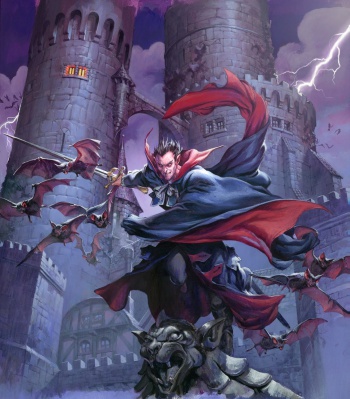 Ravenloft has a special brand of villain that deserves a little extra attention: the recurring villain. I know, recurring villains are not unique to Ravenloft, but few settings have so many baddies that are actually designed in-game to recur. Many Ravenloft Darklords--and quite a few non-Darklords--have the "Undying Soul" special quality written right into their stat block. While the means of recurrence varies, these villains all spell unending pain to any bullheaded players who just want to kill things without getting into the drama. Using such a villain is one way of persuading players that, at least in the Land of Mists, sometimes the best you can do is stop things from getting worse. With that in mind, here's a sample of the best recurring villains for your game: 1. Toben the Many--Any list of such villains has to start with the one who defines the category: Toben is the definition of recurrence. Arguably the most talked-about part of the old Van Richten's Guide to the Walking Dead, Toben stole the show in that book and has been a fan favorite ever since. His creepy eyes and grin are the stuff of nightmares, as is his matter-of-fact discussion of how much he enjoys collecting people. Pluses: Toben is perhaps the most infinitely scalable villain, ever. Let low-level PC's meet just a few of his zombie collective, and get their chills with the challenge of making sure one doesn't get away to spread the plague. Higher level ones might face a whole village of hive-minded Tobens, with the challenge being reversed: can the PC's get away from Toben? For scholarly PC's, allow them the moment to match wits with a bound or incapacitated Toben host, like the Weathermay twins did. And don't forget: the Guide to the Walking Dead is an actual book in the Ravenloft setting. Giving PC's a chance to read the book is a great way to set up for their first visit from this particular "co-author." Minuses: They say being a one-trick pony isn't bad if the trick is good enough. Toben really tests that idea. At the end of the day, the vast majority of his hosts are just creepy looking zombies, albeit slightly faster than ordinary ones. He just doesn't bring a lot to the table to enhance them with, except the single mind to coordinate them. In addition, PC's above 5th level who have met him twice will probably have developed some working strategies to minimize infection and maximize their attack value. Toben should learn to frustrate some of these strategies, but his resources to do so won't necessarily scale with the PC's gear. You can increase the number of hosts to greater and greater levels as PC's level up, but if you do this too much, your players may give up in frustration--it's like asking them to eradicate the common cold. +++++++++++++++++++++++++ 2. Harkon Lukas--Just like any such list must include Toben, Harkon also needs special recognition here. Sure, he's only one of many Darklords with the Undying Soul feature, but he's the only one to make it part of his battle strategy. Combined with his cursed berserking sword, Harkon's game of fighting to the death only to summon the sword to his new body and keep fighting has been a feature since the Black Box. Pluses: Harkon is a good foe for teaching arrogant players humility. Even if the PC's never learn it in-game, let the players learn the secret of his immortality: his soul goes to the nearest dire wolf within his domain borders. What are they going to do to stop him for good--kill every dire wolf in Kartakass AND prevent more from crossing the border from Barovia and elsewhere? Prevent the Mists from dropping just one more dire wolf off somewhere in the middle of the woods? Short of starting a wolf-centered plague, even epic PC's would be hard pressed to kill Harkon permanently. Minuses: Never forget he's a Darklord--and don't let your players forget, either. There's nothing worse than having Harkon come after high-level PC's who have already killed him so many times that they start laughing about new ways to kill him. No DL is supposed to be a joke to face, and Harkon's continual return should not be a laughing matter. If the PC's are too powerful for him to use his wandering-bard schtick, introduce them to his political prowess as Meistersinger of Skald. Whether he turns public opinion against them, or works through quislings, or works his wiles in female form, be ready to show them that Harkon Lukas is not JUST an undying soul. He's also one of the blackest. +++++++++++++++++++++++++ 3. Ejric Spellbender--while any odem (or a ghost with Malevolence) might fit the bill, Ejric was the prototype for possession horror in Ravenloft. Way back in the Book of Crypts, Ejric's takeover of a PC was the result of a magic jar spell gone wrong, but the Fraternity of Shadows has since upgraded him to an official odem in their Nocturnal Sea Gazetteer. He's still limited to taking over people who are sleeping or unconscious, but his frustrations with that limitation might get him traveling to the mainland in search of help, so don't think he's just limited to Armeikos or even Liffe. Pluses: Ejrik's use of sleeping hosts is sure to give players some moral dilemmas--just have him take over a child in a dangerous situation where expelling him might endanger the host. Subdual damage or sleep magic doesn't expel him, because his host is already unconscious. Charm and hold magic doesn't work on him either, because he's undead. If the PC's manage to ensnare his current body, he can just leave and find another. In a port town like Armeikos, there ought to always be a few drunks passed out in the many dives down by the docks, day or night. If the PC's have the ability to harm him in incorporeal form, or prevent him from controlling a host, he can just hunker down inside the host and wait it out. After all, he's got all eternity to wait. Minuses: Once PC's have figured out how Ejrik works, his days are numbered. With the right spells and/or enough holy water, a group above 5th level might manage to pin him down and destroy him for good. He's best used against a lower level party, in combination with other threats, and/or from a position of surprise, so they are not packing the right heat to destroy him. If they have faced off with him at low levels, have him run away for a while and lick his wounds, waiting until they are facing another threat before he shows up for the tag-team. On the other hand, restore his full spellcasting abilities--he was originally a 10th level wizard, why limit him to one spell?--and see if that doesn't give them a run for their money. +++++++++++++++++++++++++ 4. Jacqueline Montarri--A true gem of the 2nd Edition Monstrous Compendium II, Montarri not only set the bar high for the horrible things that could be done with a Vistani curse, but she also laid the groundwork for the truly time-warping powers of Madame Eva and the Zarova Vistani. Nor did Montarri wind up in the retcon dustbin with the arrival of Gaz1. On the contrary, she got an upgrade to the head of Red Vardo Traders and a spot with the big boys in the appendix. But what can you do with her? Pluses: Of all the villains on this list, Jacqueline Montarri is perhaps best suited to appear in many roles besides that of adversary. Red Vardo Traders might serve as a background piece to give Barovia flavor, or as transportation if the PC's are in need of a lift. They might offer black market goods for sale, or end up as rivals with the PC's in some race for a magic trinket. This gives opportunities to hear about their mysterious leader before meeting her face to face...to face. Minuses: If you are going to use Montarri as a villain, there's little point unless the PC's hear her story. Without that, she's just another crazy mad killer with her signature weapon collecting trophies from each victim. Combine this with a lengthy intro by RVT as above AND the multiple reappearances to illustrate her immortality, and she runs the risk of taking over your campaign. While I admire a go-big-or-go-home approach, this may be too much for even an experienced DM to manage. Unless you really want to build the entire campaign around the search for her head, you might be better off just letting her cameo for the sake of experienced players' geeking out. +++++++++++++++++++++ 5. Lucre the Coin Golem--Hand it to Stan! to remind us that the recurring villain need not be living or undead, but might actually be a construct, if that construct was composed of something as ubiquitous as gold coins. This contribution to the Children of the Night: Created was among the most common favorites, for obvious reasons. Pluses: Are your PC's poor? Run them through the original Heart of Gold adventure. They will have a lot of money, if they survive. On the other hand, if it's too much, or if your players getting greedy, have Lucre return and run off with all the gold. Even as PC's learn to diversify into gems, jewelry and other things Lucre can't animate, the golem can learn about buying and selling, and may start selling non-gold items to amass coin hoards for himself. Once PC's learn about his thirteen special coins, the golem will mark them for death. By the time they melt their first coin, at least two others should be scattered beyond the Core, making Lucre one of the hardest non-Darklords to kill, even when you know exactly what to do. Minuses: Lucre is a great villain to end this list with, because he embodies the weaknesses of many of the others. Like Montarri, Lucre's backstory demands to be told, and his reappearances stand to derail any other plot you may have planned. Like Ejrik, he is vulnerable in his isolated state--a single coin is helpless--and might be destroyed by mid-level spells. Like Toben, his recurrence is his best trick, and players may scale up much better than he does, as they learn what works on him. He does not share Harkon's weakness, which is perhaps his greatest failing: despite his immortality, Lucre lacks the versatility and the pathos to be a Darklord. 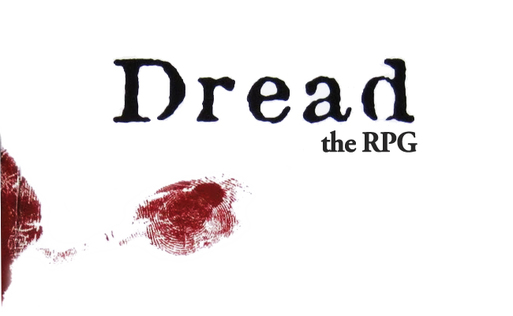 Today I role-played with three people who have never role-played in their lives. We played two different scenarios in a game called Dread. For those of you who may not know, Dread is a simple role-playing game designed to be played in a few short hours, in which each player fills out a set of character questions and the outcome of any action they take is determined by removing blocks from a Jenga set. A successful pull of a block leads to a successful action, a pull which causes the tower to topple results in the death of the offending player’s character, and an abandoned pull (to avoid the certain death of a tower topple) leads to a failed action and negative consequence. While both the GM and I are well versed in role-playing, the other three players’ experiences range from no personal exposure whatsoever to being forced to listen to stories told by their incredibly talented, handsome, and well-written husband about his many adventures. I love to be able to introduce people to gaming, as many of you probably do as well. It gives me great joy to be able to share activities I love with the people I love. It has probably been many years since you, dear reader of a role-playing blog, gamed for the first time. My guess is that your feelings about your first impressions of gaming have been long lost beneath your years of subsequent game; I know this has been the case for me. As such, l was keen to hear their feelings about the experience, both out of a hope to convert them into gamers as well as an objective interest as to how the experience, now commonplace for me, would be taken with fresh eyes. I asked each player to provide me with the most compelling impression they took away from the game: Player 1: I was surprised by how much the GM influenced the experience. It was fascinating to see the interaction between the players and the GM and how it shaped and guided the story. In particular, after both games had occurred and during further conversation with Jake, I learned more about some of the other role-playing systems (such as D&D) and how the GM can impact the way that role-playing game is experienced by the players. My initial thoughts about role-playing was that most groups were similar and it had never occurred to me that not every GM, role-playing group, or scenario will be a good fit for every player (which all seems incredibly obvious now after playing). While this might sound a tad negative, I had a BLAST and will definitely look for further opportunities to explore the world of role-playing. Player 2: As a girl and young woman I had very few instances to interact with any sort of gaming. After I got married my husband introduced me to the world of video and board games. However, I found I was very selective about the games that I found enjoyable, those primarily being story driven games. After several years I had my first chance at playing a role playing game. For me it was a very “Ahah” moment as I realized that this combined everything that I loved about gaming. Having never played before I was worried about not being able to get into the head of my character. I was surprised at how easy it was for me to slip into the fantasy. After this experience I am eager to search out more opportunities to play role playing games. Player 3: I feel like Dread helps me overcome fears. My whole life I’ve shied away when it comes to dialogue and confrontation. Being an introvert, it’s really hard for me to open up and be comfortable around people. I also struggle with self-esteem and confidence, which often keeps me from being comfortable in large groups. However, I was able to have my first role-playing experience with a group of people that I love dearly. This allowed me to open up a bit and explore a different side of my personality. Playing our first game of Dread made me very uncomfortable because not only was I forced to speak in front of a lot of people, but it was about a topic I know little about - sci-fi space exploration. By the second game however, I knew what to expect when it came to telling a story and working together as characters, but I knew going in that I had to force myself into situations and make myself contribute to the story or my character would go unexplored. Even though Dread is just a small fraction of the role-playing games available, the introduction to this game has opened my eyes and made me more willing to explore role-playing games in general (though it will have to be with the right group of people). Jake is an incredibly talented, handsome, and well-written husband who has had many role-playing adventures, most of which he has forcedly conveyed to his wife in story form. 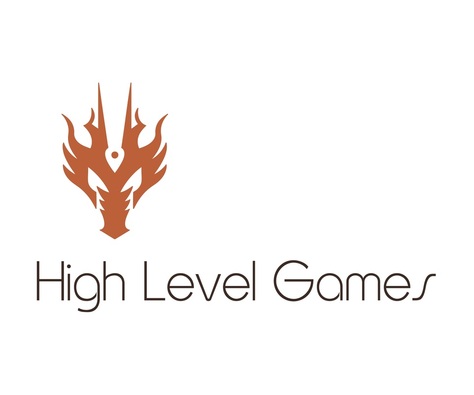 We have a vision for what we want to be, and then a bunch of smaller metrics that we want to achieve along the way. Let’s talk about what some of those are. I basically wanted to put together a hub so that gamers from all walks, from professional game designers, writers, bloggers, to just passionate fans and hobbyists like myself would be able to have a constant stream of easy to digest and interesting material about this crazy hobby we all love. To that end, a couple of us decided to go ahead and create a podcast. None of us had ever done anything like this before, or even knew what the hell we were doing, but decided that we would start to go from there. So we pooled what little money we had from our decidedly not gaming careers and we set out to figure out how to record and edit a podcast, where to host, how to design a website, how to create logos, and what kind of social media we should use. Basically, we googled a lot, took inspiration from what others were doing, and just bumbled through. Everything we have put together to this point we have done ourselves, through hours and hours of trial and error. And frankly, we are pretty damn proud of what we have achieved. As far as what we are trying to accomplish, our goals are pretty reasonable, in my humble opinion. They just take work and time. So what are the concrete, rather than broad vision, goals?
What does everyone think about this? Misguided? Something we should work towards? Thoughts? Questions? -VP Quinn 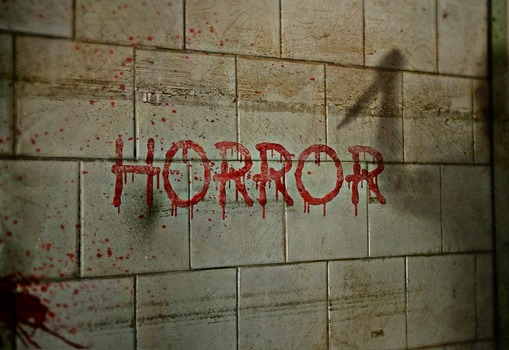 Games set in the World of Darkness were all designed as horror games. Mage though, Mage is a game that doesn’t immediately set off the horror music in your mind. Mage instead reads like a game of hope, of a search for Nirvana. Like the rest of the WoD though, Mage is a game embedded with horror elements. Sure, it’s a different kind of horror than the personal horror of Vampire: The Masquerade or the ecological and rage filled horror of Werewolf: The Apocalypse, but the horror is still a core concept within the game. Horror in Mage is often about the questions left unanswered. In a search for enlightenment, the secrets one cannot find answers to are some of the most horrifying elements. 1. Control – The Technocracy might come to mind at first; the technological organization that believes it has to control ‘sleepers’ so that it can bring the world to ascension. This sort of control boils down in the books to long detailed and scary descriptions of mind wiping and personality manipulation. On top of that, Control is an actual ‘thing’ within the Technocracy helping to lead the world to… somewhere. Control is not only the purview of the Enlightened Citizen though. Concepts of control seep through Mage in subtle ways. The Order of Hermes believes that they control the forces of the universe. They believe that they should be the ones to herd humanity into growth and enlightenment and that they will eventually find the formula to bring the world back to the height of their power, the Dark Ages. Every Mage struggles to control the world around them, to show how their version of reality is true. Control and the lack of control permeate the WoD for Mages, and stories done well around control or a lack of control can be deeply terrifying. 2. Paradigm and Consensus – The world is what we make it and for a Mage the world can literally be what they imagine. Or, it would be if consensus reality didn’t hate those who try to change the foundations of that reality. The Mage has to have a paradigm, a worldview that their magic is crafted around and through. This worldview can include everything from a hacker’s excitement over the connections we make through the internet, or the ceremonial magician that believes blood, symbols engraved on the floor, and incense can help them make connections with Hell. For the first group, they may think they are making connections with other people, but what if they are simply making an opening for monsters that inhabit the digital web? What happens when a Mage sends himself physically or in astral form into the web? Can a computer virus kill them? Do trolls cause them physical pain with their attacks? What does the Mage believe? Do they think they can be killed via the internet? We’ve all heard stories about people addicted to games that die of heart attacks at their computer… that explains why he died perhaps… and it fits our consensus of reality much better than the fact he caught a virus meant to harvest data and is now harvesting something else. 3. Paradox – This ties into the last point. Paradox is consensus reality slapping a Mage for thinking they can remake the universe in their image. Paradox can appear as a shift in luck for the Mage; the things they once did with ease no become more and more difficult. Paradox can appear as a literal hobgoblin to destroy the mage. Paradox is the boogeyman for even the most static of Technomancers. Paradox is the universe pushing back; it is the power of the sleepers en masse. Does that mean the sleepers are truly asleep? Maybe they are tapping into a more universal avatar, a connection to the universal awakened entity? A good storyteller knows how to encourage her players to get their Mages to bend reality, and slowly reminds them that they are not as powerful as they think… maybe they aren’t the ones in control of the universe… oh there is that control thing again… 4. The Universe has Secrets - Whether it is the Deep Umbra or deep in the ocean, the universe has secrets that it is trying to hide. Reality hides deeper evils than we might ever know, but the Mage is seeking ascension, so they tend to trip right over the tentacles curling around the world as we know it. Do the Nephandi truly control the Technocracy from the inside? Are the Euthanatoi actually empowering the Abyss with their interest in Entropy? What about Ether, does it exist? What is it, if it does? The Universe has secrets and it is trying to hide them but they slip out into reality and even the most dedicated of Void Engineer crews might not be successful at destroying every deviant that pops up. A good storyteller never reveals all the things hiding in the shadows of the World of Darkness, and in Mage that can be hard. Mages are seekers of truth and may run headfirst into the darkness. That drive offers a perfect opportunity to show them a tiny glimpse of the creatures hiding in the dark. 5. Magic is dying - For the traditions; they believe the lifeblood of the universe is being drained away by stasis. Magic no longer powers the world in the way it once did. For the Technocracy, the world isn’t being locked into stasis; it is instead being ordered and brought to a greater state of enlightenment. Who is right? Is the very essence of dynamic reality being funneled into a state of greater good, or is it being destroyed by forces that seek to bring a halt to everything? Or even, is the world being slowly deconstructed from the inside out by forces of entropy and the Abyss? An Akashic performs their katas every day for years, and one day, it fails. Her actions no longer change the world in the way they always have. Do they seek a new way of doing things? Or, do they feel the creep of fear from their lack of ability to do what they have always done? Maybe magic is dying, but what is taking its place? Maybe if magic isn’t dying, it is instead the hope of the mage that is dying or already dead. Control is key to Mage, and it is key to instilling the horror elements of the WoD in your Mage game. Don’t be afraid to use classic elements of horror, the unseen, the seen but subtly off, or even the powerful outside to your Mage game as well. One note, make sure your players know that you are going to use horror elements in your Mage game before you start to do so. Maybe wait a game or three before you begin to filter them in after the announcement, but you want them to be prepared for the real chance they may feel truly scared (if you do things right). The key to these situations is to allow a release and a chance to decompress afterward. You want horror to be powerful, but not overwhelming. Enjoy the World of Darkness, and try not to waken any Elder Gods while you are out there…. With 17 years of playing rpgs, Josh started with Mind's Eye Theater LARPs and loves the World of Darkness. Josh is the administrator of the Inclusive Gaming Network on Facebook, is running both a Mage game and a Dark Ages: Vampire game at the moment, and is an advocate for inclusive gaming spaces. He's also a father and a recent graduate from the International Peace and Conflict Resolution graduate program at American University in Washington, D.C. 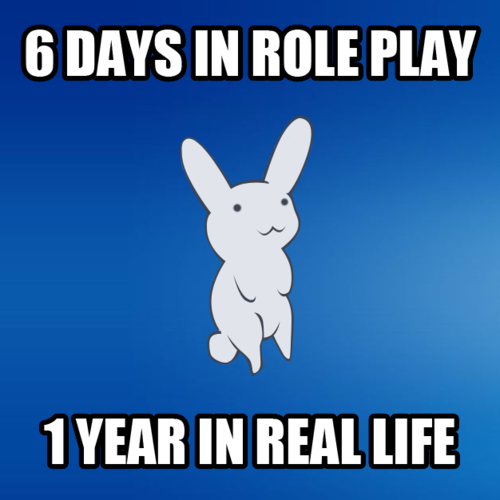 Let’s just admit it, we have all been there. Your eyes glaze over as the the rest of the party waxes not-so-eloquently on the number of arrows necessary or their insistence that 10 water skins per person is totally not excessive. Maybe, you have been stuck in that battle that never seems to end; there is a ridiculous amount of time it that takes other players to decide on exactly their next strike (the type of strike, the weapon, the target, wait, how was the wind blowing?, okay, a new weapon, and my strike would totally change, new target, the flavour). If you stopped reading during this paragraph or skimmed it, I don’t blame you. Our minds wander, our daydreams start, and we don’t always have our ‘head in the game.’ These are some tips that will keep your attention for the duration of your playing time. 1. Count the _____ game Those who argue or hem and haw over every decision can be unbearable at times. And honestly a seated activity does nothing to naturally bolster your attention. I would like to introduce you to the counting game. It originated back in the recesses of my high school career, in the tutelage of my history teacher. No one else could make WWII sound so bland. Thus began the counting of ummms within his monotone syllables. Keeping a tally made you listen for something of substance. In role-playing, this could be counting of the “buts and nos” of rules-lawyers or even the “wells and reallys" of chronic over-preparers. This should keep your mind occupied on at least part of the game. 2. Plan your next 4 moves In a slow-moving battle, it is easy to fall into the trap of daydreaming while others make their move. After they are finally finished, then it is your turn and you show up as vastly unprepared as them (though probably more unprepared because you have to stop thinking about that episode of Supernatural first). This perpetuates the inanity of it all. Instead, plan 4 moves. Write them down. Whichever one makes sense, do that one when it is your turn. Or even roll a d4; make it spontaneous. Plan something out. Use that time for the game. 3. Stand up Seriously, it helps your body and your brain. Take a short dance break. Teach yourself how to dougie. Do anything to get your blood pumping again. 4. Help move the process along I am telling you to speak up for all involved. You are all trapped in this time-sucking-sinkhole. Throw the other players a rope. Suggest that a small store probably doesn’t have 50 extra water skins lying around for each of you to have 10, so we don’t need to debate it. Tell the players that they are under attack (maybe look at them menacing or growl at them to get the point across) and their character’s first reaction may just be to use the weapon in their hands and strike the most imposing looking target. Give suggestions. You don’t need to direct their every move, but help put their heart back in the game. We all need a little help now and then. And if none of the above works 5. Light something on fire Drastic times call for drastic measures. This is where Vanessa lights things on fire. Who is Vanessa? Well, she is a sarcastic, 30-something wife and mother. She likes things and stuff, but not simultaneously. When she isn’t involved in things and stuff, she teaches middle school math and art. She loves new teenagers in action. They make her laugh and shake her head and her world is much better with laughter. She thinks everyone should be roleplaying. She sometimes bothers her friends to help with her blog articles and other times it all comes from her head… scary. . She is also trying out this new twitter handle at @sarasma_nessa 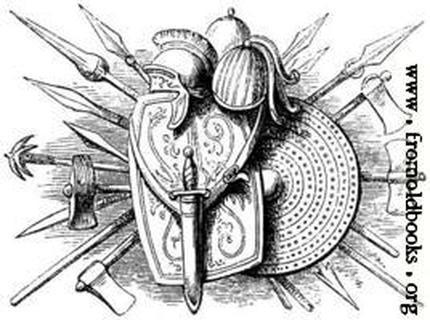 For too long I have sat by while players treat the Cleric like a second rate class. Often relegated to party healer or last minute NPC add on to balance the party (I once played with a group who had an NPC Cleric with them that they actually name Healomatix – the outrage, I didn’t last long with those fools). For anyone who wants a challenging and full gaming experience, consider the mighty Cleric and here are the reasons why: 1. Diversity of Role Playing Options and Challenges No other class offers the diversity of play that a Cleric does. No other class offers the range and depth of the Cleric, from the highest ideals of love and mercy to the deepest depravity, evil, and sadism. The Cleric offers players the ability to explore the full range of the human condition. Whereas most classes shove you in a rigid box and some classes (bards) offer a diversity of skills and abilities the Cleric offers a full set of abilities, strong spell casting, and depth of background possibilities that allow for true role-playing. 3rd level choices? Who needs those when the Cleric gets them at 1st level – right from 1st level you are developing your character so when you get to level 10 the other party members only have 7 levels of character development along their chosen class specialization. 2. Can Fill Any Role on the Party The playability of the Cleric offers gamers a unique opportunity to explore all of the other playable classes while still retaining the strong spellcasting required to bolster the whole party. For example, you could play a Cleric devoted to the gods of war, wading in to battle chanting blessings to your comrades and fallen foes alike, your holy water sprinkler casting blood and radiant energy in equal measures. Or you could worship the earth gods, using your skills to track enemies and your bow to down them. Why not worship the god of trickery where you might find your character in a tavern weaving tall tales to distract the bard while you clean up in a game of dice, then moving to the main stage to play a tune that befriends the bar keep. I once had a player who had a Cleric of the goddess of luck who used his spells and natural talent to infiltrate keeps and steal the goods, equally talented at opening locks as a true thief. In my favourite setting, the Forgotten Realms, the Clerics of Mystra gain access to sorcerous spells and stand shoulder to shoulder in their robes, wielding their staves of power, with archmages. In fact, no wizard or sorcerer can deal out the breadth of spells that a Cleric can; equal parts life and death, with a wider choice of utility spells to be readied and employed. Finally, why not a Cleric who worships the darker powers and uses their deity’s blessings to curse their foes and call down fiery death on them, or twist their minds to force them to do your bidding? 3. Fighting Ability While others may purport the fighting strength of other non-warrior classes, no other class comes as close to the warrior as the Cleric. Clad in steel, swinging sword and shield, a Cleric can be placed in the front line permanently, none of this, “for short times” stuff – the Cleric can BE the tank – if built and played properly. Oh yeah, and undead, let me just turn those to dust for you. So while the bards are singing their jaunty tunes and hiding in the background until a Tavern presents itself the Cleric employs their wisdom (arguably the most important stat), combat strength, and diverse spell casting abilities to every situation. Truly the leaders amongst all other PCs, the Cleric is the virtuoso of the group, although usually underrated. Let’s be honest, when was the last time you joined a party and said, “damnit, there’s no Bard! We’re in Trouble.” Bryan is a long time gamer, husband, and probably some other stuff too. When he’s not playing bard-slaying Clerics (who doesn’t enjoy beating a Bard to death with their own lute), he enjoys camping and surviving in the wilderness with nothing but his wits, a hardy axe, and some rope. Bryan is also an advocate for table top role-playing of all kinds and firmly believes that the exploration of the human condition, creativity, quick thinking, and socialization that they provide has made him a better person. Everybody should give this a try – regardless of what class you choose to play. Unless you choose a Bard, them I’ma smash you. 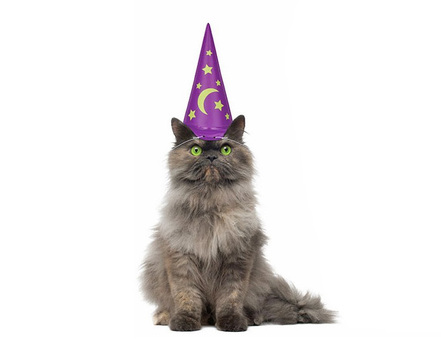 If there’s one fact that I’ve learned from the internet, it’s that people are unnaturally obsessed with cats. Reading about cats, watching cat videos, memes about cats, the list goes on and on. Invariably, once technology has reached a certain threshold, some scientist somewhere will attempt to uplift domestic cats by increasing their intelligence and giving them the ability to speak. Trust me, if there is technology that would allow for such a thing, it will happen, no question about it. Once our cats are able to think and speak as well as humans, someone will get the bright idea to invite them to role-play. It is to you whom I write! I urge you not to role-play with cats and present to you these four reasons why: 1. Cats are poor team players: Cats are inveterate loners by nature and would make no effort to play as a member of the team. Expect the cat’s character to often wander off from the group, even in the midst of a tense confrontation, probably idly chasing a small animal or rubbing against the leg of a tavern wench. Heaven forbid the cat chooses to play as the cleric, no one but them would be receiving any healing. They wouldn’t listen to the advice of any of their fellow players and would often lead their group into trouble. If your group has foolishly made the cat’s character the group leader, expect to become servants doing the whims of their master rather than adventurers fighting evil and slaying dragons. Cats would be better relegated to a role of unreliable thief or milk-obsessed hermit. 2. Cats desire to mess with everything: Cats have an inherent desire to mess with their owners’ possessions, whether it be by knocking that expensive vase off the table or shredding the drapes. This could manifest itself in game in a variety of ways. Any small or valuable items held by other players will likely end up missing, never to be found again. Unlike normal thieves, who are interested in money, I think cats would steal the items, destroy them, and discard them wherever it wouldn’t be discovered, perhaps in a sand box. It’s not just possessions that cats enjoy manipulating. Expect the cat’s character to suddenly attack random NPCs, with seemingly no rhyme or reason. Even worse, their character will likely befriend your group’s worst enemies and attempt to cozy up to them whenever they are given a chance. Given their stealthy nature, cats will likely play sneaky characters, which will often go missing and be found hours later hiding in some obvious place, just watching the rest of the party frantically searching around. 3. Cats blatantly disregard rules: Cats see no reason to follow rules set by their owners. This is incredibly problematic, as all RPGs are played according to a defined set of regulations. They would be in constant conflict with the GM, balking at any imposition inflicted upon their will for their characters. I imagine that they would be the worst sort of rules lawyer, prone to arguing every little point to the fullest extent of the possible argument. When forced to follow a rule they dislike, they will sulk and probably end up destroying something in the house of whomever is hosting (though no one will witness them doing it and they will deny it staunchly). God forbid you have a cat as a GM, as they will make up rules as it suits them and you will undoubtedly find yourself playing a game of mouse. 4. Cats startle easily: Any cat owner knows that cats startle for seemingly no reason at all. There’s no reason to think this sort of behavior won’t translate into the game. At any sign of danger, expect the cat’s character to flee and hide under a table, bush, or in any hole large enough to house them. A cat will be no help in a battle with any creatures large or even remotely loud(or wielding magical vacuums); I expect you won’t be able to find them for at least an hour after the battle has been won. Even outside of combat, expect there to be problems. If your group is sneaking into the evil baron’s castle and the cook drops a pot, the cat will invariably give away your position by his or her hissing, jumping, and scampering away. On the bright side, their characters would be fantastic at taking the night watches (though you should expect them to walk over their fellow sleeping characters every few hours or so). I know that these warnings will not prevent you, future cat-lover, from attempting to role-play with your cat. Your group will come to grief and you’ll end up having to kick your cat out, which will invariably lead to a long sulk in which the furniture in your home is mysteriously damaged, you will be unable to sleep for more than one hour at a time due to their nocturnal calls, and your life becomes generally miserable until you’ve bought them enough catnip and milk to make up for your terrible mistake. Don’t say I didn’t warn you.
 Episode One - Adam's Wrath, 2nd Edition AD&D (Ravenloft) Recorded - Posted to iTunes Episode Two - Chronica: Age of Exploration - Pathfinder - Completed - Posted to iTunes Episode Three - Rifts Mercenaries Adventure - Rifts -Editing Phase Episode Four - Lost Mine of Phandelver, 5th Edition D&D (Forgotten Realms) Episode Five - Night of the Walking Dead - 2nd Edition AD&D (Ravenloft) Episode Six - Dawn of the Artifacts 1: Dusk - 4th Edition Shadowrun Episode Seven - Greyhawk Ruins, 2nd Edition AD&D (Greyhawk) Episode Eight - Beneath the Mask, Dread RPG Check us out on iTunes! 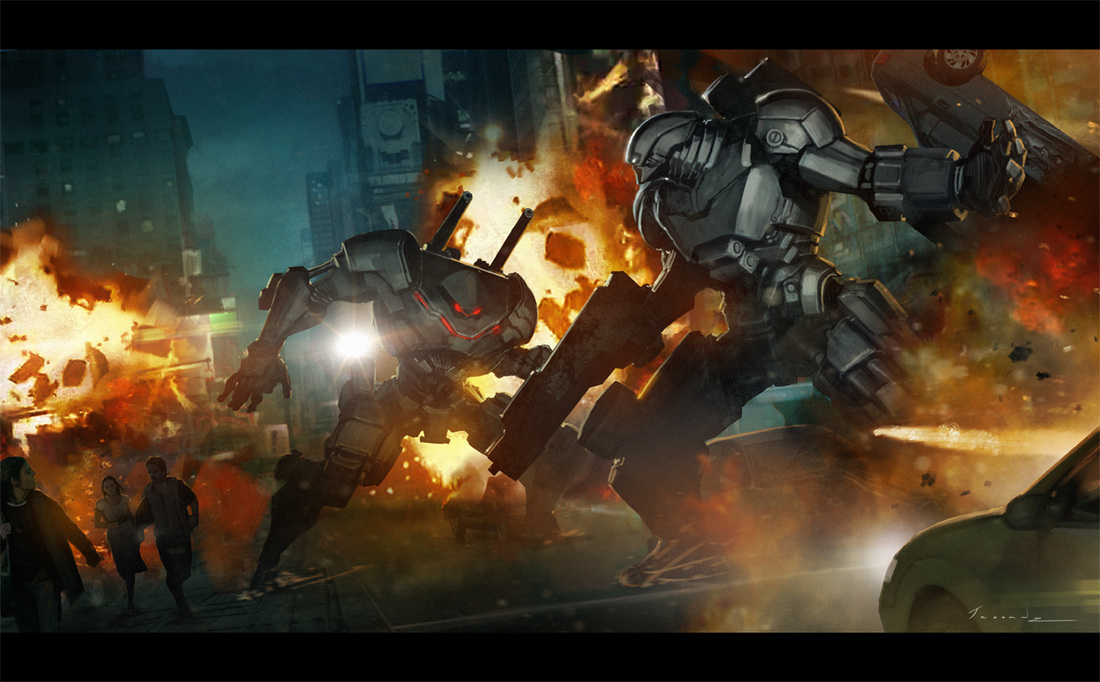 First off, I’m not talking about dystopian futures, steampunk, cyberpunk, or the post-apocalyptic game genres. I’m talking about RPGs that explore the final frontier, flip off the galactic senate, and make with the blue skinned lovin’. Secondly, I’m not talking about universal systems like GURPS Space, or adaptive theme modules like Dread RPG's Metal Sky. I’m talking about games specifically crafted to the genre of science fiction, games that take space and science, and then apply rules to them. Thirdly, I’m not talking about great science fiction RPGs like Traveller, Mindjammer, or Star Frontiers, although I probably should at some point in the future. I’m talking about TV shows and movies that have been transformed into comics and RPGs so that players can immerse themselves in their fan-boy or girl favorites. 1) Robotech (not to be confused with Macross II) I was always more into Transformers than Robotech as a kid. For those of you that don’t know the history, Robotech was one of the first anime TV shows to be released in the North American market, due to it’s success in Japan. Palladium saw the potential of the series and released the Robotech Role-Playing Game in 1986. It was a Mech lover’s dream, and it introduced the concept of mega-damage, which would go on to significantly influence RIFTS. Palladium then went further and released Robotech II: The Sentinels in 1988 and Robotech: The Shadow Chronicles in 2008. The games were a little glitchy due to translation issues with the source materials but I’m not really a giant robot suit guy so… meh. 2) Macross II Now I’m not trying to start a fight here, but as similar as the themes and games are, Robotech and Macross are not the same things. Although, they obviously are. When Robotech was adapted to North American TV markets, it was combined with 2 other, unrelated series to meet the minimum 65 episode syndication requirements. One of those series was The Super Dimension Fortress Macross. It made for confused mech-loving children on Saturday mornings. So, that being said, Macross II is a totally different universe from that of Robotech, with minimal crossover, and it has its own distinct following...right? Palladium must have loved releasing Macross II: The Sentinels in 1993, so that Robotech gamers could get their fix. 3) Firefly/Serenity So yeah, Joss Whedon gets good ideas and he’s an ok director. After Firefly ended its TV run, the fans brought it back from oblivion to the big screen. It also spawned some pretty decent comics, some borderline socialist larping clubs, and 2 different RPGs. First came Serenity- The Role-playing Game in 2005 by Jaime Chambers, produced by Margaret Weis Productions. The game was decent and won awards for its Cortex system. However, when the license for the rights expired in 2011, the fan loyalty did not. By 2013 Weis had re-acquired the rights for the game, inclusive of characters not only in the movie, but also in the series. 2015 saw the release of the Firefly Role-playing Game using the new Cortex Plus system. Both games appealed to Whedon’s fan base and sold well. PDF’s for additional content are available on DriveThruRPG. 4) Star Trek/Star Trek: The Next Generation So apparently Star Trek has a large and loyal following. Star Trek’s huge fan base called “Trekkies” demands huge content, and while there have been previous incarnations of Star Trek RPGs, Last Unicorn Games did it best. This is a case of the latter preceding the former. Last Unicorn developed their Icon system for The Next Generation, and the supplementary material even had a holodeck adventures book. Immediately after it’s release, developers started in on the original series (1999) and Star Trek: Deep Space Nine. The Star Trek: Voyager RPG was in the works, but by 2001 Last Unicorn had lost the rights to Decipher Inc, whose RPG line crumbled in 2009. The fans of Last Unicorn’s version were rewarded for their loyalty, as the writers released the majority of the uncompleted material. One former Last Unicorn writer even completed 7 new source books, and presented them to fans free online in 2013. 5) Star Wars There have been 3 iterations of Star Wars role-playing. West End Games published a decent D6 version through 3 editions, but went bankrupt in 1998. The material developed by West End Games today is still understood by most fans to be foundational in the greater Star Wars universe canon. Wizards of the Coast later picked up the license and published their D20 version in 2000. It was easily relatable to D&D players familiar with its system, however some mechanics within the system were missing or broken, and a player using their force powers was generally understood to be in God-mode. Wizards didn’t renew the rights and in 2012 Fantasy Flight Games published Star Wars: Edge of the Empire to mixed reviews. While most players thought that the unique game-developed dice were cool, they also felt that the dice dictated too much of the story, detracting from the players and DM. The mechanics of the dice also allowed for success in combat even if you didn’t hit the opposition. People loved the rulebook though. Weird. Honestly, I’ve never met anybody who plays this game, but I know a guy who rolls a lot natural ones, so I’ll recommend it to him. Space. A sea of darkness waiting to consume the last sparks of our light, a place so empty that we have to fill it with wicked adventures. Strap in and hold tight. This isn’t like dusting crops. Boldly go where no one has gone before, and when you’re there, take a look around. Not everybody can be an astronaut. About Ryan: So I try to read about 50 comics a week, depending on my ability to pay the power bill. I try to read as much new and independent works as my tried and trusted favorites, and I’ve been doing this for years. Thus, I can roughly say that I am pretty decent at comicology, however I hold no formal degree. Luckily, degrees are no substitute for common sense and that’s how I got this gig. 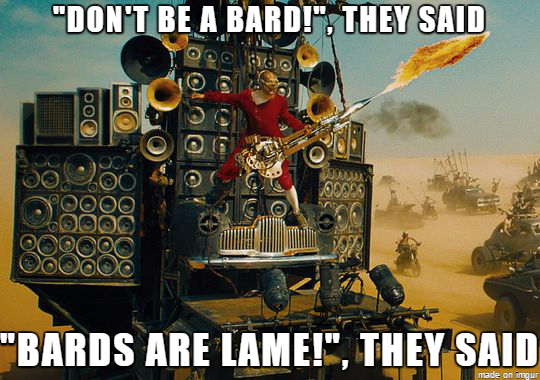 Maybe I should have titled it, “Reasons why my GM should always let me play a bard,” since that is pretty much my hope with this article. I love bards. In D&D, there is no doubt that they are the best character class. For full disclosure, my opinion may have been shaped by my first major character that I ever played. I loved that bantering, bartender bard. So I may be biased, but even at looking at the multitudes of other character options, I still remain steadfast in this belief. And this is why: 1. Good at pretty much everything Even without the mechanic of “Jack of all Trades”(which makes your skill set without equal), bards are notoriously able to be put in other’s combat spots for short periods of time. Sometimes your team is weak in one area. But with a bard, they can jump in when you need more brute force, need some magicing (it’s a new word - deal with it), or even if you need to have some cannon fodder in your fight. 2. Magic or something One of my favourite parts of the bard is their limited magic (which is not always so limited). I find it a hilarious addition that you can pull out at the most opportune of times. Sometimes, it will be in the form of a small show for raising much needed capital for your group. Seriously, adventuring doesn’t always pay too well. Or you can spring it during a pitched battle! You nonchalantly can pull it out of your pack and see how your adventuring group reacts. From Feather Fall and Speak with Animals to something damage inducing like Thunderclap, these spells can be super helpful in a pinch. 3. Charming I think I see your run-of-the-mill bard as that character which can bridge gaps within any group. Since they are a little skilled in everything, it means they can relate to everyone. In fact, I am currently playing a bard who has somehow become the leader of a group, simply due to a storytelling culture where she has those stories at her disposal. Who knew that the one with the best stories could lead? 4. Bardic Inspiration Seriously, so useful. An ever increasing die (or dice) to be given to your group members which they can use for damn near anything. It can be a phrase or a gesture to indicate how awesome you think they are (and who doesn’t like that). I like phrases along the lines of “Aye, you be a capt’n!” or “You, do you!” But whatever the suggestion, you are a gift that keeps on giving. 5. Song of Rest The age old quandary of taking short or long rests can be helped along with this ability. Sometimes, you don’t have the time or place for that long rest to occur. Maybe you just got walloped by some wandering goblins. Instead you can convince your party to take just a minor break in your day. During a short rest, you help all who hear your melodic tones gain extra hit points during that rest. 6. 3rd level decision making I love the idea of specializing later on with your character. Did they end up more combat intensive than you thought they would be? Then you can head through the College of Valor at 3rd level. Maybe they are just ridiculously skillful in helping with the planning and the spellcasting for your group,then you can head down the College of Lore. Seeing where your roleplaying takes you and having a malleable character is a great way to add depth with the skills to match. Who knows how your character will turn out within your group? I am sure people can add more to the simply gargantuan amount of reasons why the Bard is truly the best of the best. Or maybe now you are convinced to give this class a try. I will always lobby to play this class (though often it will be shut down.) Perhaps it is my flair for the dramatic that caused this love affair with bards. But I never want off this ride. This is where Vanessa writes. Who is Vanessa? Well, she is a sarcastic, 30-something wife and mother. She likes things and stuff, but not simultaneously. When she isn’t involved in things and stuff, she teaches middle school math and art. She loves new teenagers in action. They make her laugh and shake her head and her world is much better with laughter. She thinks everyone should be roleplaying. She sometimes bothers her friends to help with her blog articles and other times it all comes from her head… scary. . She is also trying out this new twitter handle at @sarasma_nessa 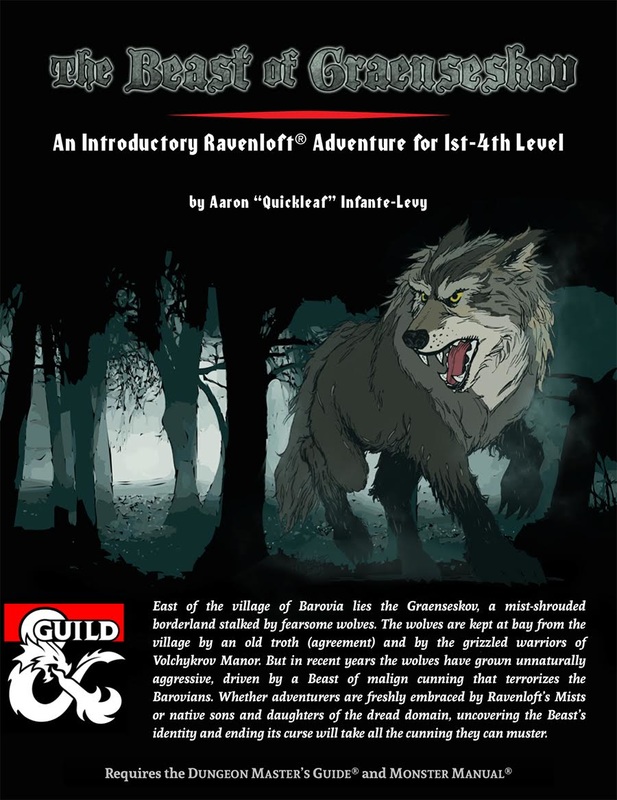 Recently I published The Beast of Graenseskov, a Ravenloft mystery adventure for 5th edition Dungeons & Dragons, on the DM’s Guild. The 79-page adventure can be found for sale here: http://www.dmsguild.com/product/180558/The-Beast-of-Graenseskov-An-Introductory-Ravenloft-Adventure. VP Quinn graciously invited me to share my experience writing the adventure with an eye toward providing other aspiring DM’s Guild authors with helpful tips mined from my extraordinary intelligence. In other words, you can learn from my mistakes. Let me introduce myself first! I’m Aaron (going by “Quickleaf” on-line), and I’ve had a few forays into RPG writing in the past, notably writing Tales of the Caliphate Night (Paradigm Concepts, 2006), a winner of Green Ronin’s True20 setting search, as well as a handful of articles for Dragon, Kobold Quarterly, and EN5ider, ENWorld’s Patreon journal supporting 5th edition. I’ve been fortunate that my RPG writing has always been a passionate hobby rather than livelihood; in real life, I’m a doctorate architecture student with a love of the outdoors. I recently started publishing on DM’s Guild with The Beast of Graenseskov and The Buccaneer’s Bestiary, and plan to release more adventures in the future. My 5 pieces of advice are: 1.Know where your concept falls within the Gothic Horror genre 2.Understand the differences between Curse of Strahd and the old Domains of Dread 3.If you’re writing to tie in with Curse of Strahd, identify a “window of opportunity” 4.Design for an evening of horror 5.Incorporate the Tarokka (optional) 6.Assemble your resources & polish your technique 1. Know where your concept falls within the Gothic Horror genre Haunted houses, ill-fated poets, moonlit graveyards, vampires, flying buttresses. That’s Gothic Horror, right? Certainly those are elements common in Gothic Horror, but what us writers are interested in are the deeper themes that constitute the genre. These include an obsession with the past, an examination of madness and other psychological states of distress or darkness, and heavy use of symbolism and repeated motifs (e.g. dreams or the dual nature of humanity). Some concept clearly fall entirely within the domain of Gothic Horror, such as the character study of Strahd in the original Ravenloft and Curse of Strahd, while others stray into the more generic Dark Fantasy or Faerie Tale genres. A good way to get a sense of where your intended adventure falls on the genre spectrum is to list a couple influences for your project. If these influences are mostly Gothic Horror, then it’s a good bet that’s the way your adventure is leaning. With The Beast of Graenseskov, my original concept was very clear: A who’s-the-monster mystery amidst the backdrop of a hag’s curse. I wanted a deceptively straight-forward concept to make the twists and turns of the adventure stand out. Early on I identified my three influences:
Be aware that there are are aspects of Gothic Horror that are harder to translate into the D&D adventure medium; notably, an emphasis on sexuality, the Gothic anti-hero, and experimental writing techniques like shifting narrators or literary tableaux. In The Beast of Graenseskov, I diluted the sexual themes of Allerleirauh and made the relationship between boyar Borje Volchykrov and his illegitimate daughter Ruzina one of unrequited parental love and betrayal, rather than inappropriate erotic love. Likewise, I introduced the possibility of the PCs using the cursed wolfskin as a weapon against Strahd, opening up the opportunity for one of them to step into an anti-hero role if they wish. Finally, I incorporated an experimental approach to the adventure by designing it so anyone of four suspects might be the Beast, depending on the DM’s choice (or the drawing of a Tarokka card). 2. Understand the differences between Curse of Strahd and the old Domains of Dread Curse of Strahd is a re-imagination of the original I6: Ravenloft adventure by Tracy and Laura Hickman. Thus, there are key differences between Curse of Strahd and the overarching Ravenloft setting described in Realm of Terror, the Ravenloft Campaign Setting, the Domains of Dread, and subsequent releases. Now, it’s possible to write an adventure that reaches a broader audience including those running Curse of Strahd and those running a Ravenloft campaign, but you’ll need to understand the differences first. A good primer to writing for Curse of Strahd was published for free by Wizards of the Coast: http://www.dmsguild.com/product/176276/Ravenloft--The-Dungeon-Masters-Guild Barovia, as it appears in Curse of Strahd is a demiplane of its own, with no connection to any other “domains of dread.” It is quite literally Strahd’s prison, frozen in time at 735 on the Barovian Calendar. All creatures ensnared within Barovia are doomed to spiritually stagnate, their souls trapped forever, reborn again and again in a tragic cycle. Because of this separation from the Outer Planes, much of Barovia’s population is actually soulless shells. Another interesting trick is that Strahd can essentially “hijack” any divination spells used to contact beings from other planes, disseminating falsehoods as if he were the entity in question. In Curse of Strahd no one escapes the ring of choking fog around Barovia. Not wishes, not artifacts, not a Vistani potion. Nothing. The exception to this are the Vistani, who in Curse of Strahd can leave the realm because of the nature of Strahd’s curse, not because of their own powers. Finally, sunlight in the demiplane doesn’t function as sunlight for creatures with Sunlight Vulnerability or Daylight Sensitivity; this makes vampires and similar creatures much more dangerous. My approach with The Beast of Graenseskov was to embrace both the original Ravenloft setting and the more isolated Barovia presented in Curse of Strahd. To that end, I kept the core of the adventure neutral in regards to setting assumptions that would make it unsuitable to either group of DMs (those favoring original Ravenloft setting, and those favoring Curse of Strahd). However, I included plenty of peripheral elements that speak to the greater Ravenloft setting, such as mentions of merchants from Nova Vaasa traversing Old Svalich Road and the invaders from the Mists worshipping a wolf-headed god. A DM running the Curse of Strahd can ignore these little tidbits, or interpret them as he or she sees fit, without the adventure suffering. Whereas a DM running a campaign using the AD&D Ravenloft boxed set might play up the Nova Vaasan border with horse thieves and mountain goblin raids, and interpret the wolf-headed god as the arcanoloth Inajira or Harkon Lukas, Darklord of Kartakass. 3. If you’re writing for Curse of Strahd, identify a “window of opportunity” I know this sounds like trite advice, but identifying a potential market for an adventure is an important step in design. Ultimately, you’ll need to be passionate about what you write to push through the rigors of design that (hopefully!) you’ll put your product through. However, all the passion in the world will fall short if your adventure duplicates material in Curse of Strahd or is superfluous to that adventure. For example, if I’d made my adventure a paint-by-numbers werewolf hunt, it would fall flat compared to the Werewolf Den already in Curse of Strahd. You can refer to the Curse of Strahd table of contents to help with this process: http://tribality.com/2016/03/01/curse-of-strahd-table-of-contents-released/ When I sat down to write The Beast of Graenseskov, once I had my concept in mind I had to determine what level I would write for. My original “playtest” of the early form of the adventure was made for about 6th-8th level. However, after reviewing Curse of Strahd it was clear there were two “windows of opportunity” when it came to a dearth of material. 1st-level characters had to face the Death House to advance to a sufficient level to tackle the challenges in Curse of Strahd. A lot of people online were saying how deadly they found Death House, and personally I found it to be a bit rushed and lacking in good adventure hooks. It’s a great haunted house dungeon, don’t get me wrong, but should it be the only entry point into Curse of Strahd? I didn’t think so. The other window was a gap in content for 3rd-4th level characters. Given the size of my adventure, I realized that toning it down for levels 1-4 would be the best window for me. Other “windows of opportunity” might include exploring other border areas of Barovia not detailed in Curse of Strahd, exploring what happens when a character (or even an entire party) dies and is resurrected by the Dark Powers, giving the PCs more opportunity to interact with Strahd as a NPC rather than fight as a monster, reintroducing an old Ravenloft monster and designing an adventure around it, reintroducing the old idea about “reality wrinkles” for outsiders, giving greater narrative time to an NPC like Van Richten, etc. 4. Design for an evening of horror There are several ways even a well-written adventure can fail. It can fail on its technical elements (e.g. the presentation, arrangement, and layout are not well done). It can fail if it doesn’t provide the experience that it advertises (e.g. a “mystery” being solved in the first game session leading to a hex crawl for the rest of the adventure). And it can fail if the design of the adventure itself doesn’t support the desired experience; this last type of failure is the most elusive to pin down… When a group buys into a Ravenloft adventure, they want that thrilling sort of chill to crawl down their spine that comes from watching a horror flick or curling up with a scary book on stormy night. There’s a lot of advice out there for horror authors and for DMs in how to evoke horror in their storytelling technique, but what about advice on how to design an adventure to evoke that feeling? For example, if you look at an adventure like the AD&D RA1: Feast of Goblyns, you’ll notice that it provides several towns with lots of adventure possibilities along with a strong framing scenario. Each town provides something creepy and unknown, such as the Old Kartakan Inn which embodies all those childhood fears of monsters under the bed. There is a sense of continuous mystery, of the ground moving under the players’ feet. This is essential in designing a Ravenloft adventure, and just as essential is keeping the mystery balanced. On the one hand, you do want a driving source of dread, a known antagonist hounding the characters, but on the other hand you never want the players to slip into being too comfortable or too blasé about the direction the think the adventure is headed in. Negotiating that balance between revelation and concealment is an art, but there are a couple lessons I can extrapolate from The Beast of Graenseskov which may be helpful:
5. Incorporate the Tarokka (optional) I mentioned the Tarokka deck earlier, and it stands out as one of the defining features of the both the original I6: Ravenloft and Curse of Strahd. While you certainly don’t need to include a drawing of the Tarokka to make an adventure feel at home in the Ravenloft setting, it does serve as a potent touchstone for players that signals “you’re in Ravenloft now.” In The Beast of Graenseskov I deliberately made the Latrova Vistani a tribe that doesn’t use the Tarokka to the same extent as other Vistani. I made that decision because I wanted to preserve Madame Eva as the Tarokka reader par excellence, and because I set up the raunie of the Latrova as have psychic powers pertaining to object reading — potentially critically helpful to the PCs during their investigation of the Beast. However, even with the Tarokka cards deemphasized, I wanted to incorporate them into the adventure as a way to randomly determine which NPC is the Beast. By creating an alternate Tarokka reading (without the High Deck “crown” cards), I provided a means for the DM to not only determine the Beast’s identity and motives, but also to locate the Beast and the hag Pretty Kolchya when the PCs come looking for those antagonists. Anything that could be randomized in an adventure could involve a Tarokka reading. For example, if your adventure involves substantial use of random encounters with named NPCs you could create a chart attaching each NPC to a card or suit of the Tarokka. Alternately, if there is a magic well with illusory Tarokka cards floating in it that acts as a random portal in your adventure, you could attach destinations in Barovia to various Tarokka cards. 6. Assemble your resources & polish your technique How do I make my product look good? Where can I find art? These questions come up a lot in conversations about publishing through DM’s Guild and its sister sites. Even though these questions aren’t specific to adventure-writing or Ravenloft, I see them come up enough that they probably deserves some explanation. As an aside, there are a lot of products on DM’s Guild that are thoroughly mediocre in terms of writing, layout, and overall polish; anyone serious about publishing on DMs Guild should NOT use those as an example of what to do. To some extent, you’re going to need to invest time to get proficient with your software of choice, add polish, and find images that are legal for use, but I can provide some online resources that I found helpful in drafting The Beast of Graenseskov. Layout Program & Workflow My best advice is use programs you know and are comfortable with, otherwise be prepared to treat your project as a time-heavy learning opportunity. Personally, the three programs I used the most in putting together The Beast of Graenseskov were OS X Pages, Adobe Photoshop, and Adobe Acrobat. The best bang for your buck with Adobe is to buy an Adobe Creative Cloud membership as a student or teacher. Usually I begin my draft in a word processor then copy that into Adobe InDesign once I’m done with spell checking. However, I’ve become thoroughly impressed by OS X Pages allowing me to do basic layout in about half the time it would take me to do similar layout with InDesign. I’ve been told that recent versions of Word and Libre Office can accomplish a similar look as Pages, but I’m less familiar with those word processors. My workflow involved three basic steps (with a lot of going back and forth): 1.Making ample use of text styles in OS X Pages, and setting up the document with custom borders/headers, and the background image watermark using section masters. Word has the same features, just with different names. 2.I spent a lot of time with the magic wand tool in Photoshop cleaning up images into PNG format, then placing them into the Pages file. I also created a few maps in Photoshop. 3.Once everything was done, I exported the file into PDF, opened it with Adobe Acrobat, and went through creating bookmarks. I had to edit and reorganize some pages, but for the most part that was the final step. Ravenloft-ian Fonts For the title I used “Black Castle” by Richard William Mueller, a Public Domain font which can be found at: http://www.dafont.com/black-castle.font For the chapter headers I used “Heidelberg” which can be found at: http://www.fontpalace.com/font-details/Heidelberg/ For other headers I used Andada SC, and for the text I used Andada, both of which are widely available online. For the dropped calligraphic capital letters I placed at the start of each chapter, I used the AromatCapsSSK font, which can be downloaded from the old Kargatane Ravenloft site (along with several other suitably Ravenloft-ian fonts) here: https://www.adnddownloads.com/en/resource/kargatane-ravenloft-fonts Free Art When it comes to DMs Guild, the five rules of the day for free art are that it must be: (a)Public Domain (and be sure it’s in the Public Domain!), or (b)CC-BY 2.0 (NOT Share Alike or any other Creative Commons license), or (c)Art for which you received written permission to use from the artist, or (d)Art you have made yourself, or (e)Art specifically released by Wizards of the Coast for free use by DMs Guild creators. To date these include a bunch of monster images which can be found by searching for Product Type > Resources for DMG Creators. I can make a couple recommendations here. There are a ton of terrific painters (many Eastern European) who’ve done work that fits the motifs of Ravenloft; some of the ones whose art I used in The Beast of Graenseskov include William Henry James Boot, Alfred Wierusz-Kowalski, Konstanin Makovsky, and Ivan Tsarevish. For high-definition images of old paintings, I looked for online galleries. Adapting and modifying Public Domain art is entirely legitimate, and you can see that I tried to emulate the look of the “splash” art in the PHB, DMG, and MM. Best practice is to note any changes you make to Public Domain work in your attribution documentation. One of the coolest sources of Ravenloft-ian Public Domain art I found was for the Scarlet Heroes RPG by Sin Nomine Publishing, which as part of their Kickstarter released a bunch of fantasy art into the Public Domain. Do you NEED to attribute Public Domain art? Technically no, but if there’s any question about the legality of art you use, having that documentation can be helpful later. Plus, it’s common courtesy to acknowledge people who’s work you’re using. Beware! You can find a lot of resources at https://www.reddit.com/r/UnearthedArcana/comments/3uwxx9/resources_open_to_the_community/ if you navigate to the Homebrew Creation Root. It’s a terrific resource for designers! However, while some of these resources are freely open to commercial use, others (such as many fonts) are covered by specific licenses. Do your homework to determine what’s legitimate to use and properly attribute others’ work. Stock Art Investing in some art can go a long way toward differentiating your product. However, an art commission can easily run upwards of $100 (if not substantially more). Since any profits on a given DMs Guild product aren’t likely to exceed that amount by much, most authors like myself will want to minimize the art budget. Stock art (such as that purchasable at drivethrurpg.com) is one of the most affordable means of illustrating an adventure. In selecting stock art for The Beast of Graenseskov, I had a specific look in mind — reinforcing that look was more important to me than finding the prettiest pieces. If maintaining an overall aesthetic to your work is important to you, consider investing in an artist who produces stock art collections. For my adventure, I chose Maciej Zagorski’s work for The Forge Studios since his collections had the right look for what I wanted to portray. However, I did need to go back and invest time converting the images into workable PNGs / TIFs (graphic formats which maintain the transparency surrounding a free-floating image). Parting Tips If you’re completely new to RPG writing, releasing a product or two as “Pay What You Want” is a great way to get your name out there. However, be aware that only roughly 1/10 (if not less!) of the people downloading your product are going to pay. For anything you’re producing with a higher investment of time and a more professional level of polish, I strongly recommend against selling as “Pay What You Want.” It’s to your advantage to compare other digital adventures of a similar length and quality and pick a price point. My last suggestion is to put the word “adventure” in your title, assuming you’re writing an adventure. Why? Because some customers using DMs Guild don’t realize that you can set search parameters to search for just adventures (for the curious it’s Product Type > Sourcebooks > Adventures). Including “adventure” in the title ensures that a customer who enters “adventure” as a search term will find your product in the hits. Also, make use of tags when setting up your product; the more specific you can be the better. For example, there is now a “Ravenloft” tag. Beyond that, have patience and enjoy the adventure-writing process! 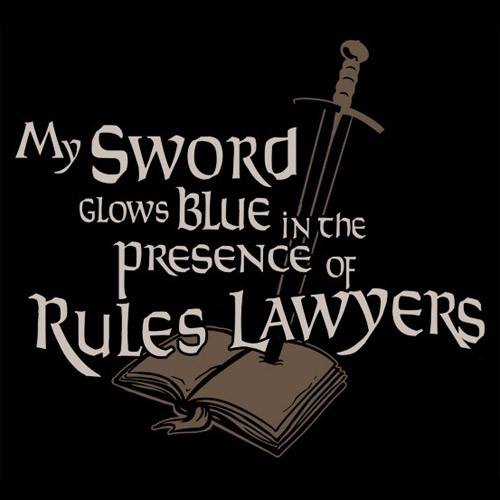 Have you ever felt cheated by your GM? Perhaps they misinterpreted what you wanted you character to do. Maybe they didn’t have a good understanding of a rule and were unwilling to alter their decision as it had already occurred. Perhaps they were bending the rules in order to suit their version of the story. Possibly they were just completely out of touch with reality. Regardless of the reason, everyone at one point or another has suffered what they feel to be a bad call. Many players are inordinately gifted with an ability to gracefully accept such decisions and get on with the game. Then there are the rules lawyers, who feel they must protest whatever injustice has been inflicted upon them in order to change the GM’s mind. It is to you that I write today: regardless of the rightness of your cause, your behavior is unacceptable. It holds up everyone’s game and is just plain rude. By all means, let the GM know if you disagree with one of their calls. However, if the GM is unwilling to alter their decision, do not attempt to: Prove your point using logic, reason, reality, and/or cold hard facts: when a dispute arises, stop the game while you look for indisputable evidence in any rulebook (does not need to be a core book) in support of your argument. Once you’ve presented your evidence, deliver a brilliant speech detailing conclusively why you are right and the GM is wrong. Finish with an explanation of how the scenario should have played out, if the GM would but agree that you are correct. If the GM rejects these proofs, go back to the rulebooks to find another rule in support of your point of view and repeat process until you get the desired results. I understand how tempting this is, really, I do. However, it is a very simple and quick way to irritate everyone with which you are playing. Fear not, my good lawyers, for I am here to help you. I present to you some tips that you can use to distract yourself from the injustice at hand. Note that I said distract, not justify the GM’s decision, as I do think you’ve been wronged in some way, as rules lawyers typically base any opposition to the GM in either rules or reality. However, for everyone else at the table, the following behaviors on your part will be largely preferable to rules lawyering:
So, as you can see, there are plenty of perfectly suitable responses to disagreements with the GM that don’t involve rules lawyering. Choose your favorite(s) and employ them the next time the GM botches a call; your entire group will thank me. Happy gaming! Jake is a rule fanatic and recovering rules lawyer. He typically employs numbers one, seven, and ten when tempted to be a rules lawyering (and number six when no one’s around). 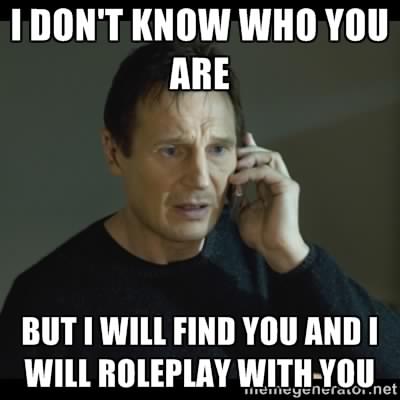 I know, as much as I hope, not everyone will be a role-player. Not everyone who plays will even necessarily enjoy it. I think it is a fabulous hobby that allows me to spend time with friends and blow off some steam from my busy week. Here are some common protests that you may hear during the course of your life and my answers to them.
For the most part, I would agree. Much role-playing focuses more on the long term, rather than the short. However, there are games meant to be shorter and more succinct. And they aren’t missing any of the great things about role-playing. For example, I played my first Dread game this year and I was blown away by the simplicity of the mechanic (Jenga!) and the tension it created. I am not sure how long the game lasted from start to finish but it wasn’t long. 2. Bad spiritual stuff and dangerous stuff People with these thoughts always have a story. That anecdote of that friend/relative/friend of a friend/neighbour’s cousin that went to the dark side. Not only did they go to the dark side, but they also played Dungeons & Dragons. You don’t need facts or causality to have a nasty opinion of role-playing, but you should consider that there just isn’t enough data to make any such conclusions. Really, advocating against role-playing is advocating against older kids or adults playing pretend (although in a more complex form.) ‘People Against Pretend’ (PAP), also has a terrible ring to it. 3. Only geeks and nerds play these games The 80s called and want your stereotypes back. 4. I just don’t get it You know, you never really go ‘get it’ until you have actually tried it. I attempted to answer a few questions in previous blogs here and here. Questions about winning and which characters are better. But it is an experience like no other. Every game, every group, and every GM is different. 5. It sounds like it is just the worst It actually isn’t. This article was written by Vanessa who is a sarcastic, 30-something wife and mother. She likes things and stuff, but not simultaneously. When she isn’t involved in things and stuff, she teaches middle school math and art. She loves new teenagers in action. They make her laugh and shake her head and her world is much better with laughter. She thinks everyone should be roleplaying. She sometimes bothers her friends to help with her blog articles which you can see here and here. She is also trying out this new twitter handle at @sarasma_nessa  I’ve been gaming for a very long time, I first started playing Dungeons and Dragons when I was 9 years old. My older brother and I used to sit on his bedroom floor and raid dungeons until he was old enough to start running campaigns and he found some friends to join us. Back then it was just the 6 of us in our basement for, sometimes, days on end. Skip forward a (ahem) few years and things have changed enormously. Now I find myself alone in my basement plugged in to my computer in a campaign with people from all over the world. My current party has a Dungeon Master in Israel, an Elven Fighter from Germany, a Dragonborn Monk from England, a Half-Orc Barbarian in Denmark, a Human Assassin in the U.S., and myself – the Lizardfolk Druid from Canada. Our exploits are posted online for the world to see. I’m not telling you anything you don’t already know but the rapid growth of communication technology has made it possible to connect gamers in a global community and makes it possible for everyone else with an internet connection to watch in awe of our amazing gaming prowess. While this is awesome (!!) it requires a slight shift in perspective; when I first started gaming online for an audience there was a bit of a learning curve and nobody I could lean on for guidance so here you go, a little bit of advice from one nerd to another. 1. It’s not just about your group of friends anymore The most important thing to know and remember is that when you start gaming online for an audience is that some people, maybe lots of people, are going to watch. It used to be that what happened in the dungeon stayed in the dungeon… not anymore, keep that in mind. 2. Tech Speed, bandwidth – do I need to say anything else? If you don’t have the capacity to video chat smoothly, while checking online resources, and possibly streaming music, not only will you have a miserable experience, but so will the other players. One screen can be enough but who doesn’t want two or three! When your DM is throwing monsters at you and you need to check the rule book for your next turn, toggling between the video chat/mapping software and your character sheet or an online reference can take you away from the action. If you can have multiple screens running or multiple computers, do it. Don’t be afraid to do some things old school. I keep my spell book and a copy of the rules at hand because I know where certain things are by feel. Some DM’s allow you to use a paper character sheet and roll actual dice, while others want everything done online. Personally, I’m a little reluctant to trust in randomization software when I have a perfectly good set of dice, but the technology is here now and we just have to get used to it. We use Roll20 as our platform and I can attest to the randomness of their dice rolls. It doesn’t feel them same pressing a button, and it’s not as fast when you need to roll something weird but it is posted for everyone to see and believe me it feels the same when the software spits out a '1' when your druid-turned-crocodile is trying to pull the boat of party members away from the Duergar death trap. Use a good headset / mic and:
3. Be Considerate This isn’t to say that you're rude, what I mean is that you need to consider a few new things:
4. Story Telling Sometimes when you're playing online the DM will use battle maps and tokens that can be manipulated to improve combat situations, but not all do. Even if maps and tokens are used there is very little “visual” happening on the screen, except for your lovely faces (sometimes), so it is up to us to make the story interesting for our viewers. Don’t be afraid to weave drama and comedy into the story, the DM can’t be the only one doing this and it makes things much easier for the DM if the players are contributing too. Ultimately any role playing is collaborative story-telling and a good group of players will take individual ownership of their responsibility in the story and try to make it a story worth listening to. A note on comedy and drama: you're going to be acting for a global audience, try to avoid cultural stereotypes, clichés, and anything else that might not be understood by someone from another continent. I thought the joke about the moose and maple syrup was hilarious* but the half-orc just stared at me like I just stole his favourite axe. (*Editor's Note: As a fellow Canadian, I can certainly attest that the one about the moose and the maple syrup is a national treasure, eh? - VP Quinn) 5. Interesting Characters / Development Similar to my points above about story-telling, your characters are key to making an online gaming session worth watching or listening to. While I love the standard characters, we’ve seen them a million times and we know how they will react to a given situation. Build up an interesting character with wants and needs, fears and loves – this is what will engage viewers and keep them coming back. A good back story is essential for this; how do you get in to the mind of a character without a past? How do you develop a character who has no motivators? In a game session with limited - or no - maps, minis, or movement (you can’t really step away from the camera) you need to provide the DM, other players, and viewers with a rich, 3-dimensional character or you risk a yawn fest. What makes online role playing engaging is wondering what the characters will they do next and why. 6. Know your character and the rules that support it I can’t state this enough. It’s important in face-to-face gaming, but it’s even more important when your online. In my experience gaming sessions online are short, you have to allow for a number of time zones and schedules and often players have other obligations which is why they are choosing online gaming as a means to get their fix. Further, you need to consider the viewers, even if it’s not something that motivates you the DM and some of the other players want people to watch them and want them to like it. So take the time between sessions to level, go through your feats, spells, and racial abilities and know them, at least well enough to avoid lengthy delays. When it’s not your turn you should be paying attention to the other players, NPCs, and bad guys, how else will you weave an epic story together, however if you have to look something up, do it while the other players are taking their turn not when it comes to you. I hope this helps you kick down the door to online role playing and takes away some of the nervousness that you might have of performing for a global audience. It’s not that bad, once you get in to the story, everything else just fades away. Bryan E. Sali A.K.A. Skeeish im Madshek, Dark Wanderer of the 5 Tribes, keeper of the eggs, and Initiate of Semuanya.  Picture it now. Its gaming day and everyone has found their way from addresses across the city to arrive at their gracious host’s abode. Chairs are pulled up around a table; lights are dialed to a hue conducive to both setting the mood and having everyone able to read their sheets. You’re excited. Today, this scratched wooden table and creaky faux leather chairs will be transformed into the background for the stuff of legends. But being legendary works up one’s appetite… Yet, what ho?! You’re in luck! Someone brought snacks! If you are anything like me, then this is the perfect recipe for gaming: Put friends around table, combine equal parts comedy and drama, add a cup of snacks, stir and enjoy. Today’s quintessential list is to illuminate gamers everywhere of the 6 essential elements of eating etiquette (alliterative gamer edition). 1. Don’t Double Dip Say it with me now: “I will not double dip the chip in the dip.” I may or may not be the only one at the table who thinks this is gross. But my contacts worldwide assure me that there is an invisible empire of those who take a stand against the double dipping of chips, vegetables and unsuspecting slow-dance partners. The reasoning driving this anti-double dip movement is quite simple: the hand to mouth pathway was designed to be one-way. This means there is no reason to stick your fingers in your mouth when eating, as this creates an undesigned return journey. If you break this law of nature by taking that half-quarantine-worthy food that was in your acid pit and put it back into a communal fluid container, its like forcing the rest of us through some sort of salivary right of passage. The only difference is, rights of passage should happen only once…anything more than that looks very similar to conversion-torture. 2. Purifying your Provision Procuring Paws. Ah the finger lick, made famous by Sisqó (that’s what he was talking about, right?). In addition to violating the one-way street mentioned above, here’s something else to think about. The next time you are bringing a doomed cheezie to your Sarlaccian pit, and it leaves some of its sticky cheese entrails on your fingers: resist that urge… You know the one- that subtle, easy and so-divine moistening of your fingers between your sumptuous lips. The gaming table is not the place, time, or suitable companions for this type of behavior. You will inadvertently make eye contact with your friend across the table with your digit firmly in your mouth. Trust me, there are some things you just can’t unsee. [A word to the wise- it turns out this awkward phenomenon applies to eating popsicles as well] 3. Foul Fetid and Funky Fragrances Us gamers move bowels like we’re getting paid by the pound. Hey, it’s not our fault we’re prematurely ready for hibernation! But there is also a dark side to our bodies… we are known to pick our noses and scabs as we pick our heroic feats, we mindlessly scratch our butts like it’s a favorite animal, and then there are the farts…oh the farts… Many gamers still carry scars from those pungent chemical spills, and the concomitant acute oxygen deprivation <shudder>. And lets not forget here to mention that body odor is not miraculously cured by two swipes of deodorant – especially on hot summer days, or marathon gaming sessions. The challenge I issue to every player: find those mystical hidden waterfalls, rumored to be lying dormant somewhere in nigh every castle. These waterfalls should manifest themselves at least every 24 hours, and if fortune smiles upon you, there may be some elixir that you can anoint your body with, thereby further fortifying your constitution (at least in scent). 4. Sweet, Salty Salmagundian Sustenance There is a law of diminishing returns with snacks, which is easily remedied by variety. The sweet is never as sweet without the salty. And the salty isn’t as salty without the sweet. There’s a life lesson in there somewhere, I’m sure. Of course, this excludes the [ insert DM’s favorite snack bribe] which can also serve as an opportunity for revenge, but mix it up a bit for your fellow gamers. Some popular choices are: pizza pops, nachos, gummies, chocolate almonds, jellybeans, garlic bread, kettle cooked anything, and butter toffee covered anything. This will help ensure maximum caloric intake for you and your friends. Now, although I’m no doctor, I’m pretty sure those calories are metabolized by the imagination and thereafter transferred from player to character, enabling maximum heroism. 5. Swiper sans Swiping Think: what would Dora the Explorer say about your snacking habits? Are you the Swiper of your group’s snack table? Here’s a checklist to see if you’re a snacking rogue: - Do you only take snacks when no one is looking? - Do you only eat and never contribute to the stash? - Do you swiftly snatch seconds hoping nobody notices? - Do you hide food in your pockets or game bag? If you answer yes to any of these questions, then you may be a snacking rogue. Be aware, because adult Dora the Explorer might come after you… 6. Beware Beverage Bifurcation To beer or not to beer, that is the question. Whether ‘tis nobler in the mind to suffer The slings and arrows of outrageous (DM decisions), Or to take up arms against a sea of troubles, And, (by drinking heartily), end them. ---Hamlet (revised Dustinopolis edition) Myself? I like a good brew with gaming- but the key word there is “a” (or maybe “a +1”). Very rarely does my role playing experience take a turn for the better with more drinking (although the potential for laughter-induced nasal eruptions rises considerably) Pop, coffee, hot chocolate and tea are all great alternatives to the wobbly pops. Ultimately it depends a great deal on your group makeup- some people want lowered inhibitions to get their game flowing. Other people want caffeine to jump-start their creativity. The rest just need enough liquid to prevent dehydration from seas of salty goodness. One point to note is that DMs should always keep their “wits” sharp, as controlling groups of players (especially ones imbibing) is like trying to herd cats. Consider the following evidence: players constantly ignoring the DM’s suggestions, players physically leaving the room at inconvenient times, and players “accidentally” knocking their dice off the table. These feline tendencies are regular hurdles in most gaming groups and, like any physical exercise, drinking alcohol makes them that much more difficult to navigate. So there you have it. Snacking is a process that all players enjoy. So bring a deuce of chips, avoid scratching your butt before plunging your hand into kettle-cooked goodness, keep your saliva in its cave, and say hi to Gene on a regular basis. Until next time Keep your dice “20” side up! Dustinopolis is a regular blogger, full time Netflix watcher, and part time grown up. He has 3 cats that are actively engaged in a psychological warfare campaign against him after he forgot to give them their wet food once…3 weeks ago. You can also not follow him on twitter @devourcheese (millions of users do so). As this is my seventh blog post, I desired a list of seven items. And what list is more seveny than the Seven Deadly Sins. I have copied such great historical allegory, subtracted the weighty theology and moralism, and crammed them into the role-playing universe. ‘Deadly sins’ is probably a bit strong, given the meager weight of the offenses, but it’s a catchy title that got you to click on this link. So, keeping in mind my high valuation of honesty, here I present to you seven mild-to-moderate annoyances of role-play:
So thus ends the seventh list, composed of seven items ripped from a list of seven other items. I know that everyone’s pet peeves are different and there are bound to be a few that should have made the list. Everyone who has role-played for a decent amount of time has inevitably been guilty of some, if not all, of the items on this list; I know I certainly am. Also, I will definitely not be writing a list of eight items for next week. I’m not paid nearly enough for that. Happy gaming! -Jake is an avid outdoorsman, board gamer, role-player, husband, scientist, video gamer, and history buff. Thus ends the last list of seven items he will make, ever. You can read his non-seven-related previous posts here and here. |
All blog materials created and developed by the staff here at High Level Games Archives
April 2023
Categories
All
|
Proudly powered by Weebly
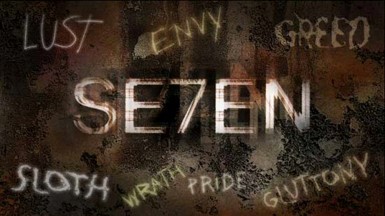

 RSS Feed
RSS Feed